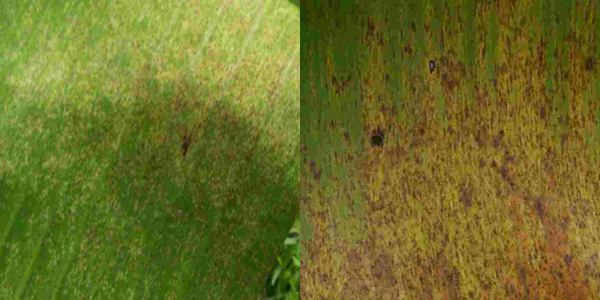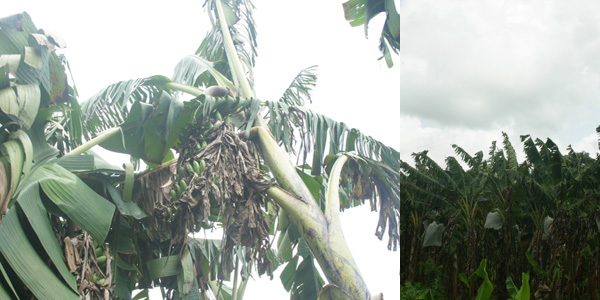Anthracnose Disease of Banana

|
Importance of the
problem |
Anthracnose is a
widespread disease of banana fruits. The disease produces
unsightly blemishes on the fruit peel, which make them unacceptable
to consumers. Infection normally begins as small black circular
specks during the pre-harvest stage. Affected fruits ripen
prematurely, rot and eventually shrivel.
|
|
Common signs and
symptoms |
•
Infection begins as small, black circular specks on the flowers and
peel of the fruit at the distal end of the hands.
• Salmon pink coloured spore masses of the pathogen appears as the
lesion increase in size and coalesce to form large sunken blackened
areas mainly at the fruit ankles.
• Affected fruit ripens prematurely, rots and eventually shrivel.
• The disease may spread to crown and affects other fingers also.
|
|
Problems with similar
symptoms |
The symptoms are characteristic of the
disease and can be easily distinguishable from other diseases.
|
|
Causal organism and
their spread |
Anthracnose fruit rot is caused by
Colletotrichum musae. High humidity, high temperature and the
presence of rain promote infection. The conidia of the fungus
survive in dead and decaying leaves and fruits. They get dispersed
by water, wind and insects.
|
|
Mechanism of damage |
The conidia adhere to the fruit peel
and start producing inoculums when the fruit start ripening. The
fungus also enters the fruit through small wounds in the peel. It
later germinates and produces fungal appressoria that initiate the
expression of symptoms.
|
|
Ideal management
strategy |
• Minimize
damage to the fruit while harvest and storage.
• Wash the fruit with water to remove the inoculums to the level
possible.
• Maintain the fruit in a hard, green state until ripening.
• Spray the bunches with Indofil M 45 (0.25 %) or Bavistin (0.05 %) and
later cover the bunch. |
|
References |
1. Jones, D.
R., (1998) Diseases of Banana, Abaca and Enset, CABI Publishing, United
Kingdom
2. NRCB (1998) Banana Cultivation: Technical Know How and Do How,
National Research Centre on Banana, Tiruchirapally
3. Rao, V N M (1998) Banana, Indian Council of Agricultural Research,
New Delhi.
4. KAU (2002) Package of Practices Recommendations: Crops, Kerala
Agricultural University, Vellanikkara. |
Banana Bract Mosaic Disease of Banana
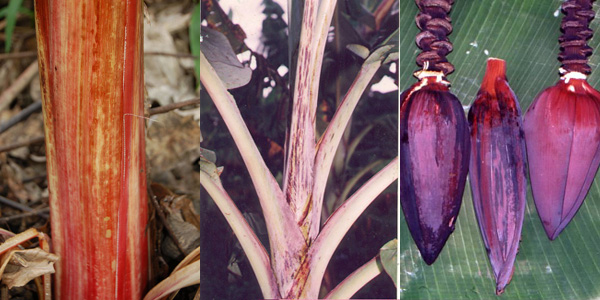
|
Importance of the
problem |
Banana bract
mosaic disease is one of the most serious virus diseases of banana. The
disease is popularly known as ‘Kokkan’. The disease causes pinkish
lines on the pseudostem and leaf sheaths. And the infested palm
looks more like a traveler’s palm. Since, the disease is caused by
virus, chemical control is of no use. Therefore, special care should
be taken to prevent disease infestation.
|
|
Common signs and
symptoms |
•
Reddish/pinkish streaks of few mm to 10 cm length appear on the
pseudostem, petiole and midrib
• Later the pinkish streaks turn to dark brownish or blackish and
become necrotic streaks which remain throughout the growth period
• Numerous reddish/pinkish streaks make the entire pseudostem
reddish or pinkish
• Outermost leaf sheath will be more reddish or pinkish and it
progress to the inner sheath as reddish or pinkish streaks
• The outer leaf sheaths detach from the pseudostem in succession
and break at the base
• Sometimes vertical spits can be seen on pseudostem
• Leaves are arranged in both sides of the affected plant in a
single plane giving a traveller’s palm appearance
• Leaves produced will be gradually reduced in size with reddish or
pinkish petiole and midrib
• Lamina shows mosaic mottling and becomes brittle
• Affected plant produces only a small bunch with chlorotic to dark
brown streaks on the bracts
• The fingers are small, curved and widely divergent with pale green
to ashy green colour as compared to healthy ones
• The bunch never matures and fingers rot
• The fingers take more time for ripening and pulp is unfit for
consumption
• New suckers from diseased plants show necrotic streaks or abnormal
colour on the pseudostem
|
|
Problems with similar
symptoms |
The symptoms of banana bracts mosaic
disease are characteristic of the disease and can be easily
distinguished.
|
|
Causal organism and
their spread |
Banana bract mosaic disease is caused
by a virus called banana bract mosaic virus (BBMV). The disease is
transmitted locally in a persistent, circulative manner by the
banana aphid (Pentalonia nigronervosa). Distribution over long
distances occurs by the movement of infected vegetative planting
material such as suckers, corms, and tissue-cultured plantlets.
Banana bunchy top disease is not soil-borne and is unlikely to be
spread on cutting tools.
|
|
Mechanism of damage |
The banana bracts mosaic virus is
systemic and therefore is present in all plant parts, including the
rhizome and the suckers. The virus is transmitted by the banana
aphid Pentalonia nigronervosa. The disease symptom appears in about
35 to 45 days after inoculation by the insect. The aphid is required
to feed on the infected plant for a minimum of about 17 hours before
it can transmit the disease and the incubation period inside the
vector may be from 90 minutes to 48 hours, and they retain the
infective capacity for about 13 days. The vector usually attacks the
host around the basal portion of the pseudostem, but at times they
may be found on the upper leaf sheaths and petioles. The insect may
carry the disease to long distances.
|
|
Ideal management
strategy |
• Eradicate
and destroy all infected plants and suckers along with roots
• Affected stools can be destroyed by spraying kerosene or by injecting
herbicides like 2,4-D
• Do not take suckers from affected fields
• Use disease free suckers for planting. Use tissue culture plants and
certified, disease free suckers
• Observe strict quarantine regulations in disease free areas
• Avoid growing leguminous and cucurbitaceous vegetables as intercrop
• Before planting, spread lemon grass in the pits |
|
References |
1. Jones, D.
R., (1998) Diseases of Banana, Abaca and Enset, CABI Publishing, United
Kingdom
2. NRCB (1998) Banana Cultivation: Technical Know How and Do How,
National Research Centre on Banana, Tiruchirapally
3. Rao, V N M (1998) Banana, Indian Council of Agricultural Research,
New Delhi.
4. KAU (2002) Package of Practices Recommendations: Crops, Kerala
Agricultural University, Vellanikkara. |
Boron Deficiency Disorder in Banana
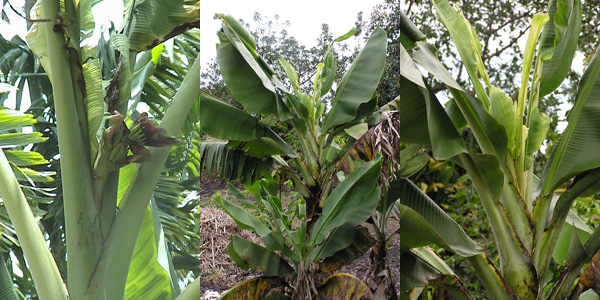
|
Importance of the
problem |
Boron is an
element needed for the formation of starch from sugars. To establish
a crop yielding 50 tones per hector per year, the plant need 1.27 kg
of boron per hector per year. If sufficient quantity of organic
manure and mineral nutrients are not added, deficiency of boron will
be noticed.
|
|
Common signs and
symptoms |
• Boron
deficiency occurs more in humid areas
• In deficient plants, the veins are very close, raised above the
lamina and leaves become brittle initially
• In later stages, chlorotic spots parallel to midrib and
corrugation and laddering symptoms also appear and unfolding of leaf
is delayed in addition to the yield reduction
• Interveinal chlorosis and striation at right angles to main veins
• Leaves curl and become deformed. Flag leaf is also deformed
• Leaf tip exhibits browning and breaks
• Severe deficiency causes all growth to stop
• Distal part of the inflorescence comes out and the basal part gets
stuck up at the throat
|
|
Problems with similar
symptoms |
Calcium and sulphur deficiency
symptoms also come similar with boron deficiency symptoms. In
calcium deficiency, there is marginal chlorosis and in sulphur
deficiency pale green to yellow discoloration. These can be
distinguished from boron deficiency where there are perpendicular
streaks across the veins.
|
|
Causal organism and
their spread |
Boron deficiency is caused when the
recommended soil concentration of boron in soil goes below the range
0.1 to 1.0 p.p.m.
|
|
Mechanism of damage |
The physiology of boron tolerance and
boron toxicity is not well understood.
|
|
Ideal management
strategy |
• Apply
organic manure at the recommended rate
• Apply borax @ 20-50 g/plant at the time of planting (depending on
severity)
• Give foliar spray of boric acid (2 g per litre) at fourth and fifth
month of planting.
• In Rasthali, spraying 0.5 % Boric acid (5 g per litre) during 4th and
6th month reduces lumpiness besides increasing the bunch yield |
|
References |
1. Jones, D.
R., (1998) Diseases of Banana, Abaca and Enset, CABI Publishing, United
Kingdom
2. NRCB (1998) Banana Cultivation: Technical Know How and Do How,
National Research Centre on Banana, Tiruchirapally
3. Rao, V N M (1998) Banana, Indian Council of Agricultural Research,
New Delhi.
4. KAU (2002) Package of Practices Recommendations: Crops, Kerala
Agricultural University, Vellanikkara. |
Bronzing or Maturity Staining Disorder
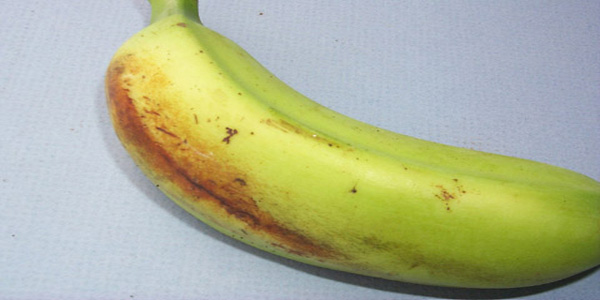
|
Importance of the
problem |
Bronzing is a
stress related physiological disorder that occurs in banana fruits.
The affected fruits show characteristic discoloration and cracking
of the peel.
|
|
Common signs and
symptoms |
•
Symptoms include discolouration and cracking of the peel.
• It begins as a light brown tinge on the outer exposed portion of
fingers,
• progresses into reddish brown stripes and patches and finally
develops into solid dark brown lesions.
• Later this dries and forms longitudinal cracks
|
|
Problems with similar
symptoms |
The problem is characteristic of the
disorder and can be easily distinguished.
|
|
Causal organism and
their spread |
The problem is caused due to stress
during the flower emergence and development stage.
|
|
Mechanism of damage |
The cells of the underlying layers of
banana peel expand at a faster rate for a long period of time than
epidermal cells. This pattern of growth gives rise to a point of
weakness at the cell edge. Further, the epidermal cells are
subjected to circumferential stress during fruit growth and it
exceeds its elastic limit and separation of cells at anticlinal
walls of adjacent epidermal cells. Hence, red brown discoloration
occurs.
|
|
Ideal management
strategy |
Avoid stress
during the bunch emergence and development stage. |
|
References |
1. Jones, D.
R., (1998) Diseases of Banana, Abaca and Enset, CABI Publishing, United
Kingdom
2. NRCB (1998) Banana Cultivation: Technical Know How and Do How,
National Research Centre on Banana, Tiruchirapally
3. Rao, V N M (1998) Banana, Indian Council of Agricultural Research,
New Delhi.
4. KAU (2002) Package of Practices Recommendations: Crops, Kerala
Agricultural University, Vellanikkara. |
Bunchy Top Disease of Banana
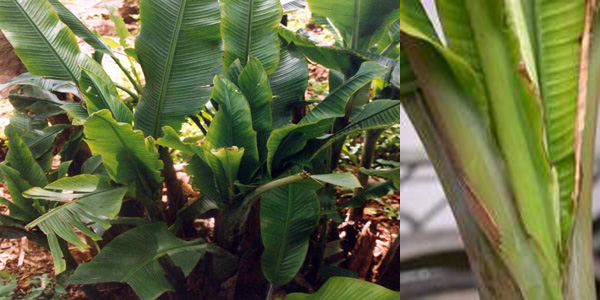
|
Importance of the
problem |
Bunchy top is a
major viral disease of banana. The disease is prevalent throughout
the country and causes widespread damage. It is caused by a virus
which does not have any chemical control. Therefore, careful
selection of planting materials and management methods is very much
essential for managing the disease.
|
|
Common signs and
symptoms |
•
Prominent dark green streaks occur in the petioles, midribs and
along the leaf veins. This is the most characteristic symptom for
early diagnosis
• Irregular dark green streaks appear on leaves. Leaves become dark
green, small, brittle and erect with prominent veins
• The leaves will get bunched together at the apex of the pseudostem
to form a rosette or bunchy top
• The whole plant gets stunted as the leaf stalks fail to elongate
• Subsequently produced leaves become smaller. Finally leaf
production stops
• Newly produced suckers become infected, stunted and produce
numerous thick, dark green necrotic leaves
• Plants infected at an early stage of development do not produce bunch, though with later infections a distorted bunch may be formed.
In very late infections, the only symptom to occur may be dark green
streaks on the tips of the flower bracts of the bell.
|
|
Problems with similar
symptoms |
The symptoms are characteristic of the
disease and can be easily distinguishable from other diseases.
|
|
Causal organism and
their spread |
Bunchy top disease is caused by a
virus called banana bunchy top virus. The disease is transmitted
locally in a persistent, circulative manner by the banana aphid (Pentalonia
nigronervosa). Distribution over long distances occurs by the
movement of infected vegetative planting material such as suckers,
corms, and tissue-cultured plantlets, banana bunchy top disease is
not soil-borne and is unlikely to be spread on cutting tools.
Colocasia esculenta is the symptom less reservoir of the virus.
|
|
Mechanism of damage |
The bunchy top virus is systemic and
therefore is present in all plant parts, including the rhizome and
the suckers. The virus is transmitted by the banana aphid Pentalonia
nigronervosa. The disease symptom appears in about 35 to 45 days
after inoculation by the insect. The aphid is required to feed on
the infected plant for a minimum of about 17 hours before it can
transmit the disease and the incubation period inside the vector may
be from 90 minutes to 48 hours, and they retain the infective
capacity for about 13 days.
The vector usually attacks the host around the basal portion of the
pseudostem, but at times they may be found on the upper leaf sheaths
and petioles. The insect may carry the disease to long distances.
The bunchy top virus has also been transmitted to Heliconia sp.
also.
|
|
Ideal management
strategy |
• Eradicate
and destroy all infected plants including suckers along with roots
• Affected stools can be destroyed by spraying kerosene or by injecting
herbicides like 2,4-D
• Do not take suckers from affected fields
• Use disease free suckers for planting. Use tissue culture plants and
certified, disease free suckers
• Observe strict quarantine regulations in disease free areas
• Avoid growing leguminous and cucurbitaceous vegetables as intercrop
• Before planting, spread lemon grass in the pits
• Karpooravally, Kanchikela, Njalipoovan and Koompillakannan are less
susceptible varieties.
• Control must be practiced across a whole production area to avoid the
rapid re- infection of virus-free planting material. |
|
References |
1. Jones, D.
R., (1998) Diseases of Banana, Abaca and Enset, CABI Publishing, United
Kingdom
2. NRCB (1998) Banana Cultivation: Technical Know How and Do How,
National Research Centre on Banana, Tiruchirapally
3. Rao, V N M (1998) Banana, Indian Council of Agricultural Research,
New Delhi.
4. KAU (2002) Package of Practices Recommendations: Crops, Kerala
Agricultural University, Vellanikkara. |
Burrowing Nematode Attack in Banana
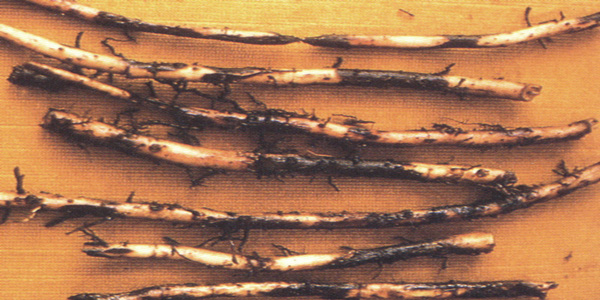
|
Importance of the
problem |
Nematode is one of
the major limiting factors to banana production. There are four
economically important nematode pests for banana. They include
burrowing nematode, root lesion nematode, spiral nematode and
root-knot nematode. These nematodes attack root and causes damage on
them. As a consequence the plant becomes week and sometimes gets
toppled.
|
|
Common signs and
symptoms |
-
The
first symptom of the attack is a small dark spot/ lesions on the
root.
-
Narrowing of leaves and delayed flowering results out of the
attack.
-
The number of fruits in the bunch is reduced and individual fruits
are small
-
Affected plants do not respond to fertilizers, irrigation or
cultural practices. Nematode population builds up rapidly in ratoon
crops
-
The infected plant topples over easily during wet and windy
weather because of inadequate anchorage.
|
|
Problems with similar
symptoms |
The nematode attack causes stunted
growth and yellowing. Eventually the plant will get broken at the
crown region. Similar symptoms are caused because of rhizome rot,
rhizome weevil attack, drought etc.
|
|
Causal organism and
their spread |
|
|
Mechanism of damage |
The nematode feeds on the root tissue
by piercing inside. Extensive feeding result in formation of gall
that blocks the conduction of water and nutrients. Fungi rapidly
invade such damaged root tissue. The infected plant topples over
easily during wet and windy weather because of inadequate anchorage.
|
|
Ideal management
strategy |
-
Apply neem cake (250-400 g/pit) at the time of
planting. This reduces the pest population. There should be adequate
moisture in the soil when pesticide is applied
-
In endemic areas, apply saw dust or neem cake in the soil and irrigate
one month prior to planting
-
Varieties like Kadali, Ney Poovan, Kunnan etc are tolerant to nematode
attack.
-
Saw trap
crops such as cowpea, daincha in the interspaces and plough them
when they start flowering.
|
|
References |
1. Jones, D.
R., (1998) Diseases of Banana, Abaca and Enset, CABI Publishing, United
Kingdom
2. NRCB (1998) Banana Cultivation: Technical Know How and Do How,
National Research Centre on Banana, Tiruchirapally
3. Rao, V N M (1998) Banana, Indian Council of Agricultural Research,
New Delhi.
4. KAU (2002) Package of Practices Recommendations: Crops, Kerala
Agricultural University, Vellanikkara. |
Calcium Deficiency Disorder in Banana
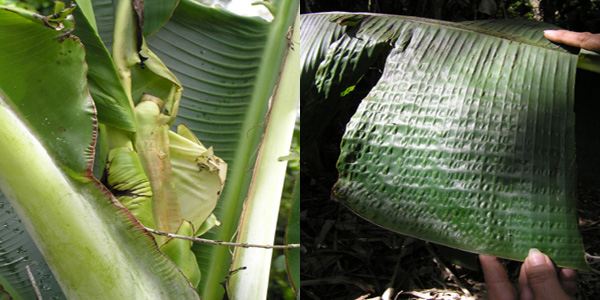
|
Importance of the
problem |
Calcium is an
element needed for the maintenance of cell wall constituents. It
also neutralizes the soil from the ill effects of acidity and
creates a conducive atmosphere for plant growth. To establish a crop
yielding 50 tones per hector per year, the plant need 227 Kg of
calcium per hector per year. If sufficient quantity of organic
manure and lime are not added, deficiency of calcium will be
noticed.
|
|
Common signs and
symptoms |
•
Deficiency symptoms appear in the younger leaves owing to low
mobility of calcium within the plant
• Early foliar symptoms include yellow stripes parallel to leaf
midrib and crinkling of leaves
• Leaf thickening and marginal interveinal chlorosis as the plant
grows
• If the deficiency is severe, the leaves develop serrated or saw
like margins and are completely deformed
• Heart leaf exhibits chlorosis followed by necrosis
• Prolonged and severe deficiency prevents the emergence of new
leaves and ultimately the plant dies
• When plants outgrow their calcium or boron supply it results in
deformed, bunchy and yellow leaves at the center/top of the plant
resembling bunchy top disease.
|
|
Problems with similar
symptoms |
Deformation of the flag leaf can also
be induced by poorly placed herbicide applications such as
glyphosate and can be erroneously confused with deficiencies of Ca,
Zn or B. Similarly, symptoms of viral attack can be mistaken for
deficiencies of these elements. To confirm that the plant does not
have banana bunchy top disease, check closely for symptoms such as
Morse code and petiole streaking that represent the bunchy top
disease
|
|
Causal organism and
their spread |
Calcium deficiency can be caused by
one or more of the following:
• Small amounts of available Ca in soil (degraded, acid, sandy
soils)
• Alkaline pH with a wide exchangeable Na:Ca ratio resulting in
reduced Ca uptake. Use of irrigation water rich in NaHCO3.
• Wide soil Fe:Ca or Mg:Ca ratios resulting in reduced Ca uptake.
• Excessive N or K fertilizer application resulting in wide NH4:Ca
or K:Ca ratios and reduced Ca uptake.
• Excessive P fertilizer application, which may depress the
availability of Ca (due to formation of Ca phosphates in alkaline
soils).
|
|
Mechanism of damage |
Calcium is a constituent of Ca
pectates, important cell wall constituents also involved in
biomembrane maintenance. It helps in cell wall stabilization as an
enzyme activator, in osmoregulation, and in the cation-anion
balance.
Ca is less mobile in than Mg and K. Because Ca is not retranslocated
to new growth, deficiency symptoms usually appear first on young
leaves. Ca deficiency also results in impaired root function and may
predispose the to Fe toxicity.
|
|
Ideal management
strategy |
• Apply
recommended dose of organic manure (10 kg per plant)
• Apply lime as per necessity based on soil test result |
|
References |
1. Jones, D.
R., (1998) Diseases of Banana, Abaca and Enset, CABI Publishing, United
Kingdom
2. NRCB (1998) Banana Cultivation: Technical Know How and Do How,
National Research Centre on Banana, Tiruchirapally
3. Rao, V N M (1998) Banana, Indian Council of Agricultural Research,
New Delhi.
4. KAU (2002) Package of Practices Recommendations: Crops, Kerala
Agricultural University, Vellanikkara. |
Choke Throat Disorder in Banana
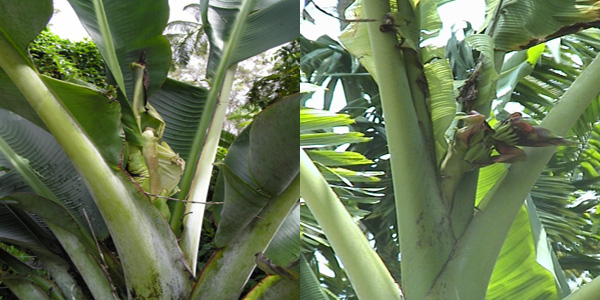
|
Importance of the
problem |
Choke throat is a
disease of banana caused by low temperature. When low temperature
synchronizes during flowering, bunch emergence is affected. Half
emerged bunches is the characteristic feature of the disease. The
disease can also delay the harvest time by 5-6 months.
|
|
Common signs and
symptoms |
• It is
due to low temperature affecting active growth of the plant
• Leaves become yellow and in severe cases, the tissue gets killed
• Bunch development is normal, but when the time of flowering
synchronizes with low temperature, the bunch is unable to emerge
from the pseudostem properly.
• The distal part of the inflorescence comes out and the basal part
gets stuck up at the throat. Hence, it is called Choke throat
• Maturity of the bunch is delayed by about 5-6 months
|
|
Problems with similar
symptoms |
Deficiency of Calcium and Boron also
leads to similar symptoms. However, choke throat is very much
characteristic to the physiological disorder and occurs only when
low temperature synchronizes the flowering period.
|
|
Causal organism and
their spread |
Chock throat is caused when low
temperature period synchronize the bunch emergence period.
|
|
Mechanism of damage |
The normal emergence of bunch is
stopped because of the disease. The distal part of the inflorescence
comes out and the basal part gets stuck up at the throat
|
|
Ideal management
strategy |
• Provide
shelter belts
• Plant low temperature tolerant varieties
• Adjust the time of planting, to prevent rapid cooling during cold
spells
• Adopt corrective measures for calcium and Boron deficiency, if
necessary |
|
References |
1. Jones, D.
R., (1998) Diseases of Banana, Abaca and Enset, CABI Publishing, United
Kingdom
2. NRCB (1998) Banana Cultivation: Technical Know How and Do How,
National Research Centre on Banana, Tiruchirapally
3. Rao, V N M (1998) Banana, Indian Council of Agricultural Research,
New Delhi.
4. KAU (2002) Package of Practices Recommendations: Crops, Kerala
Agricultural University, Vellanikkara. |
Cigar End Rot Disease of Banana
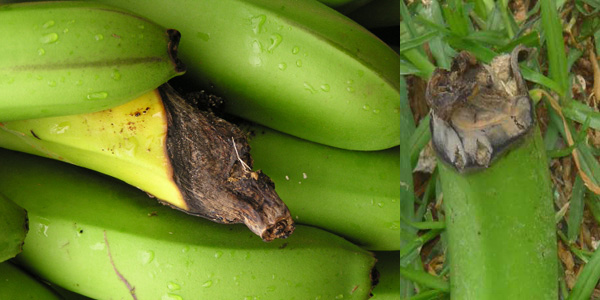
|
Importance of the
problem |
Cigar end rot is
an important disease of banana. The disease is prevalent in almost
all banana growing tracts. The disease affects the developing
fingers. The tip end of the fingers gets dried up and resembles the
greyish ash of a cigar. And such fingers are readily rejected in the
market. Therefore, control of the disease is very much important in
banana cultivation.
|
|
Common signs and
symptoms |
• A black
necrosis spread from the perianth into the tip of immature fingers.
• The pulp of the affected fruit undergoes a dry rot. The dry rot
can spread up to 2 cm from the tip.
• The corrugated necrotic tissue become covered with the mycelia of
the fungi and resembles the greyish ash of the cigar-end.
• If emerging fingers are affected, the entire fingers sometimes get
rotten.
|
|
Problems with similar
symptoms |
The symptoms are characteristic of the
disease and can be easily distinguishable from other diseases.
|
|
Causal organism and
their spread |
Cigar end rot is caused by the fungus
Verticillium theobromae. The incidence of the disease is found to be
high during summer season. The fungus is commonly seen in leaf trash
and flowers. Conidia are disseminated in air currents and infect
drying flower parts.
|
|
Mechanism of damage |
A black necrosis spread from the
perianth into the tip of immature fingers. The pulp of the affected
fruit undergoes a dry rot. The dry rot can spread up to 2 cm from
the tip. And such fingers are readily rejected in the market.
|
|
Ideal management
strategy |
• Field
sanitation, such as the removal of dead, hanging leaves from plants,
will reduce inoculum level.
• The floral remaining should be removed immediately after flower
emergence and bunches should be covered with polyethylene bag.
• Packing stations and ripening room need to be kept clean to minimize
the chances of post harvest infestation.
• Infected fingers should be removed immediately.
• Spray bunches with Indofil M 45 (0.25 %) or Bavistin (0.05 %) and
later cover the bunch. |
|
References |
1. Jones, D.
R., (1998) Diseases of Banana, Abaca and Enset, CABI Publishing, United
Kingdom
2. NRCB (1998) Banana Cultivation: Technical Know How and Do How,
National Research Centre on Banana, Tiruchirapally
3. Rao, V N M (1998) Banana, Indian Council of Agricultural Research,
New Delhi.
4. KAU (2002) Package of Practices Recommendations: Crops, Kerala
Agricultural University, Vellanikkara. |
Cordana Leaf Spot Disease of Banana

|
Importance of the
problem |
Cordana leaf spot
is one of the most important fungal diseases of banana. The disease
is prevalent in almost all banana growing tracks. The disease
produces eye shaped spots with definite concentric zonations. These
spots later joins and causes yellowing and drying of leaves. Therefore, management of the disease is very
much important in banana cultivation.
|
|
Common signs and
symptoms |
-
Yellow or pale brown oval shaped spots appear near the leaf
margins of lower leaves
-
As
the spots develop, the central necrotic area develops concentric
zonation with surrounding yellow halo
-
Individual spots enlarge or several spots coalesce to form large
infected areas
-
When
the leaf margins are infected, small concentric spots develop
which is later converted into long stripes of pale brown
necrotic tissues. The stripes sometimes extend upto midrib
|
|
Problems with similar
symptoms |
There are a number of leaf spots
diseases in banana. The leaf spot caused by Deightoniella torulosa
is characterized by an inverted ‘V’ shaped appearance. In case of
freckle leaf spot, numerous minute black spots cover the leaf
lamina. The Sigatoka leaf spot is characterized by pale yellow/dark
brown/black streaks running parallel to veins, especially on lower
leaves.
|
|
Causal organism and
their spread |
Cordana musae
The inoculums spread
through water and air. And the growth of the fungus is accelerated
in hot and humid condition with frequent rains. The spread of the
fungus is rapid in closely planted fields.
|
|
Mechanism of damage |
The fungus on infection causes
distraction to the plant tissue. This in turn causes considerable
reduction in the photosynthetic area and yield.
|
|
Ideal management
strategy |
- Remove and destroy severely
affected leaves.
- In severe cases, spray 1%
Bordeaux mixture or 0.4% Mancozeb (4g/L) along with stickers
- Oil based formulations of
copper oxy chloride (Oleop) @ 0.2-0.4% (2-4g/L) is also
recommended
|
|
References |
1. Jones, D.
R., (1998) Diseases of Banana, Abaca and Enset, CABI Publishing, United
Kingdom
2. NRCB (1998) Banana Cultivation: Technical Know How and Do How,
National Research Centre on Banana, Tiruchirapally
3. Rao, V N M (1998) Banana, Indian Council of Agricultural Research,
New Delhi.
4. KAU (2002) Package of Practices Recommendations: Crops, Kerala
Agricultural University, Vellanikkara. |
Deightoniella Leaf Spot Disease of Banana
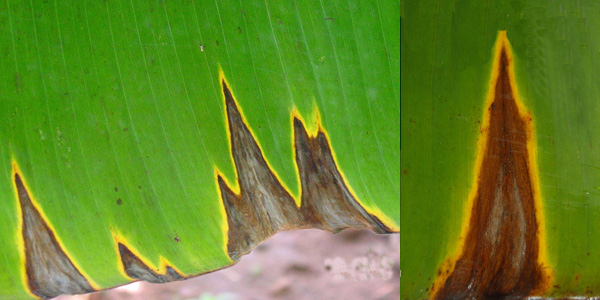
|
Importance of the
problem |
Deightoniella leaf
spot is very much common in banana gardens. The disease is
characterized by presence of inverted ‘V’ shaped leaf spots towards
leaf edge. The reduction in photosynthetic area, stunted growth and
yield loss results out of the disease. Therefore, appropriate
control measures need to be adopted in accordance with the disease
severity.
|
|
Common signs and
symptoms |
• The
fungus causes three forms of the disease viz. black spot on leaf,
fruit tip discolouration or black tip and fruit spot/speckle
• Round, pin point, black spots appear on the main veins of the
lamina in the proximity to the leaf margin
• Gradually, these spots increase in size with narrow yellow margin
• The large spots dry in the centre with pale brown areas extending
to the edge of the leaf blade giving the spots an inverted ‘V’
shaped appearance
• On fruits, black discolouration below the perianth advanced with
irregular areas or yellowish margins along the fruits
• In some varieties, nearly round reddish brown spots or spots with
black centre and a darker green, water soaked halo may be seen
|
|
Problems with similar
symptoms |
There are a number of leaf spots in
banana. The leaf spot caused by Deightoniella torulosa is
characterrised by an inverted ‘V’ shaped appearance. In case of
freckle leaf spot, numerous minute black spots cover the leaf
lamina. The Sigatoka leaf spot is characterized by pale yellow/dark
brown/black streaks running parallel to veins, especially on lower
leaves.
|
|
Causal organism and
their spread |
A fungus called Deightoniella torulosa
is the causal organism of the disease. The fungus is present in dead
banana leaves and inoculum is produced during periods of rain and
dew. Spores are violently discharged, when the humidity declines,
and become airborne.
|
|
Mechanism of damage |
The fungus is air born. The spread of
the fungus is rapid in closely planted fields. The fungus on
infection causes distraction to the plant tissue. This in turn
causes considerable reduction in the photosynthetic area and yield
loss.
|
|
Ideal management
strategy |
• Adopt
proper sanitation and good drainage of field
• Removed and destroy affected leaf portions and fruits
• Spray 1% Bordeaux mixture or 0.4 % mancozeb(4g/L) along with stickers
in severe case
• Oil based formulation of copper oxy chloride (Oleop) @ 0.2-0.4%
(2-4g/L) is also recommended |
|
References |
1. Jones, D.
R., (1998) Diseases of Banana, Abaca and Enset, CABI Publishing, United
Kingdom
2. NRCB (1998) Banana Cultivation: Technical Know How and Do How,
National Research Centre on Banana, Tiruchirapally
3. Rao, V N M (1998) Banana, Indian Council of Agricultural Research,
New Delhi.
4. KAU (2002) Package of Practices Recommendations: Crops, Kerala
Agricultural University, Vellanikkara. |
Disorder Caused by Poor Drainage
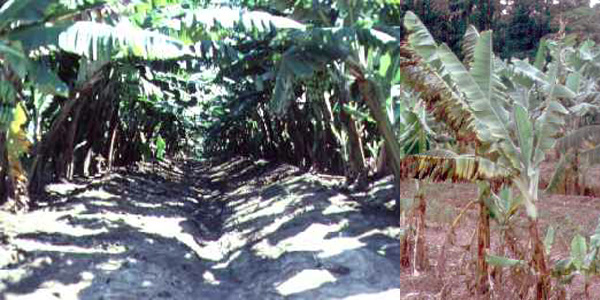
|
Importance of the
problem |
Banana is a plant
that is very much sensitive to water. When the plant is kept under
water logged situation for two or more days, leaf starts showing
yellowing. And when the situation continues, the leaf sheaths start
separating. Therefore, ensuring proper drainage is very much
important in banana cultivation.
|
|
Common signs and
symptoms |
•
Yellowing of the leaf
• Separation of the leaf sheaths
|
|
Problems with similar
symptoms |
Yellowing of leaves can be caused
because of many reasons. However, if the yellowing is caused after
water logging, the problem can be confirmed
|
|
Causal organism and
their spread |
Water logging for two or more days
continuously results in the problem.
|
|
Mechanism of damage |
Continuous submergence affects the
conducting tissue. As a consequence yellowing of leaf happens.
|
|
Ideal management
strategy |
• Ensure
proper drainage in the field |
|
References |
1. Jones, D.
R., (1998) Diseases of Banana, Abaca and Enset, CABI Publishing, United
Kingdom
2. NRCB (1998) Banana Cultivation: Technical Know How and Do How,
National Research Centre on Banana, Tiruchirapally
3. Rao, V N M (1998) Banana, Indian Council of Agricultural Research,
New Delhi.
4. KAU (2002) Package of Practices Recommendations: Crops, Kerala
Agricultural University, Vellanikkara. |
Problem from Excess Suckers
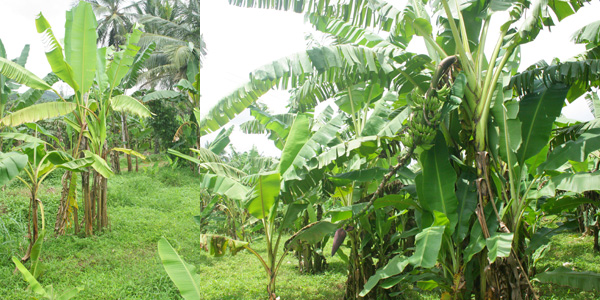
|
Importance of the
problem |
Suckers are young
banana plants seen surrounding the mother plant. They form the
planting materials for the next crop. However, when the suckers are
produced before, six months of the growth of the mother plant, a
greater share of absorbed nutrients will get translocation to the
suckers. This adversely affects the growth and development of the
mother plant.
|
|
Common signs and
symptoms |
|
|
Problems with similar
symptoms |
Stunted growth can be caused because
of a number of factors. And over production of suckers is one among
them.
|
|
Causal organism and
their spread |
When sucker production is not
controlled in the initial growing period of banana, the problem can
occur.
|
|
Mechanism of damage |
The young suckers compete with the
mother plant for water and nutrients. This adversely affects the
growth ad development of the mother plant.
|
|
Ideal management
strategy |
-
De-suckering should start from two months after planting of banana.
The side suckers should be removed by cutting at their base.
Hereafter, a few drops of kerosene should be poured inside it to
arrest further growth. And the process should repeat every 45 days
till the plant flowers. After bunch emergence, restrict the number
of suckers to two.
|
|
References |
1. Jones, D.
R., (1998) Diseases of Banana, Abaca and Enset, CABI Publishing, United
Kingdom
2. NRCB (1998) Banana Cultivation: Technical Know How and Do How,
National Research Centre on Banana, Tiruchirapally
3. Rao, V N M (1998) Banana, Indian Council of Agricultural Research,
New Delhi.
4. KAU (2002) Package of Practices Recommendations: Crops, Kerala
Agricultural University, Vellanikkara. |
Freckle Leaf Spot Disease of Banana
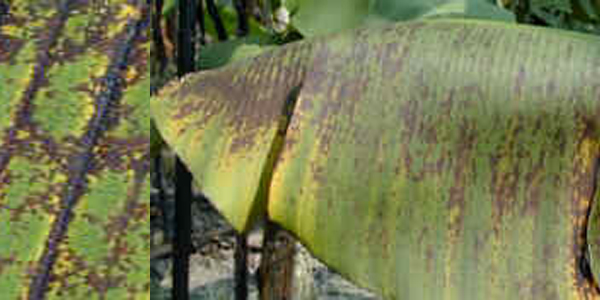
|
Importance of the
problem |
Freckle leaf spot
is very much common in banana gardens. The disease is characterized
by the presence of numerous minute black spots in large numbers. The reduction in
photosynthetic area, stunted growth and yield loss results out of
the disease. Therefore, appropriate control measures need to be
adopted in accordance with the disease severity.
|
|
Common signs and
symptoms |
• Very
small dark brown to black spots develops
on the upper surface of the older leaves.
• This gives the leaf a sooty appearance and rough texture.
• Sometimes, spots may cluster in lines and appear as streaks
running diagonally or horizontally across the leaf or from the mid
rib to the leaf edge along the veins.
• Severely affected leaves will become yellow, wither and die
prematurely.
|
|
Problems with similar
symptoms |
There are a number of leaf spots in
banana. The leaf spot caused by Deightoniella torulosa is
characterized by an inverted ‘V’ shaped appearance. In case of
freckle leaf spot, numerous minute black spots cover the leaf
lamina. The Sigatoka leaf spot is characterized by pale yellow/dark
brown/black streaks running parallel to veins, especially on lower
leaves.
|
|
Causal organism and
their spread |
Freckle leaf spot is caused by a
fungus called Phyllosticta musarum. The fungus develops in wet
weather and in heavy rainfall. The spread is mainly through rain
splashes.
|
|
Mechanism of damage |
The pycnidia stage of the fungus is
present on the host and cause damage. The nature of damage will be
distraction of tissue and subsequent reduction in photosynthetic
rate.
|
|
Ideal management
strategy |
• Remove
wilted and dried leafs frequently and follow proper field sanitation.
• In severe cases, spray 1% Bordeaux mixture or 0.3% Mancozeb (3g/L)
along with stickers
• Oil based formulations of copper oxy chloride (Oleop) @ 0.2-0.4%
(2-4g/L) is also recommended |
|
References |
1. Jones, D.
R., (1998) Diseases of Banana, Abaca and Enset, CABI Publishing, United
Kingdom
2. NRCB (1998) Banana Cultivation: Technical Know How and Do How,
National Research Centre on Banana, Tiruchirapally
3. Rao, V N M (1998) Banana, Indian Council of Agricultural Research,
New Delhi.
4. KAU (2002) Package of Practices Recommendations: Crops, Kerala
Agricultural University, Vellanikkara. |
Fruit Spot Disease of Banana

|
Importance of the
problem |
Deightoniella
causes small black spots on fruits. The affected fruit loses its
market value in accordance with the level of severity. Hence,
management of the disease before it affects the fruits much is very
important.
|
|
Common signs and
symptoms |
• The
fungus causes three forms of the disease viz. black spot on leaf,
fruit tip discolouration or black tip and fruit spot/speckle
• Round, pin point, black spots appear on the main veins of the
lamina in the proximity to the leaf margin
• Gradually, these spots increase in size with narrow yellow margin
• The large spots dry in the centre with pale brown areas extending
to the edge of the leaf blade giving the spots an inverted ‘V’
shaped appearance
• On fruits, black discolouration below the perianth advanced with
irregular areas or yellowish margins along the fruits
• In some varieties, nearly round reddish brown spots or spots with
black centre and a darker green, water soaked halo may be seen
|
|
Problems with similar
symptoms |
The disease can be easily
distinguished based on its symptoms.
|
|
Causal organism and
their spread |
A fungus called Deightoniella torulosa
is the causal organism of the disease. The fungus is present in dead
banana leaves and inoculum is produced during periods of rain and
dew. Spores are violently discharged, when the humidity declines,
and become airborne.
|
|
Mechanism of damage |
The fungus is air born. The spread of
the fungus is rapid in closely planted fields. The fungus on
infection causes distraction to the plant tissue. This in turn
causes considerable reduction in the photosynthetic area and yield
loss.
|
|
Ideal management
strategy |
• Adopt
proper sanitation and good drainage of field
• Remove and destroy affected leaves and fruits
• Spray 1% Bordeaux mixture or 0.4 % mancozeb(4g/L) along with stickers
in severe case
• Oil based formulation of copper oxy chloride (Oleop) @ 0.2-0.4%
(2-4g/L) is also recommended |
|
References |
1. Jones, D.
R., (1998) Diseases of Banana, Abaca and Enset, CABI Publishing, United
Kingdom
2. NRCB (1998) Banana Cultivation: Technical Know How and Do How,
National Research Centre on Banana, Tiruchirapally
3. Rao, V N M (1998) Banana, Indian Council of Agricultural Research,
New Delhi.
4. KAU (2002) Package of Practices Recommendations: Crops, Kerala
Agricultural University, Vellanikkara. |
Hard Lump Disorder in Banana
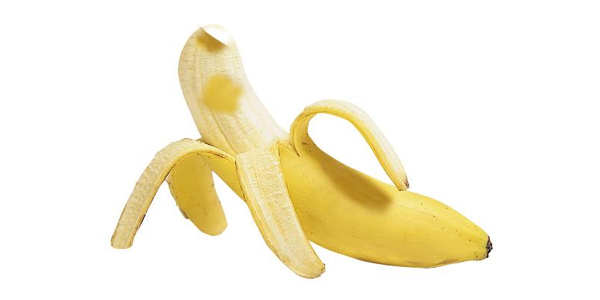
|
Importance of the
problem |
Hard lump is a
condition affecting the fruit on maturity. Here the pulp becomes
hardy in some areas and the taste become astringent. This normally
happens when bunch emergence occurs during dry winter months. The
fruit quality is greatly affected because of the disease. The
disease is seen commonly in Rasthali.
|
|
Common signs and
symptoms |
• Hard
lump or masses of varying sizes and shapes occur in the pulp
• Lumps are pinkish brown in colour and more firm than the usual
pulp and taste like immature or unripe fruits, with the result that
the quality of the fruit is affected
|
|
Problems with similar
symptoms |
The symptoms are very much
characteristic to the physiological disorder.
|
|
Causal organism and
their spread |
Occurrence of hard lump is seasonal
and only bunches emerged during dry winter period exhibit the
phenomenon
|
|
Mechanism of damage |
The bunch emergence during winter
results in high accumulation of tannin in the fruit. The high
concentration of tannin blocks the conversion of starch to sugar.
This ultimately results in pinkish discoloration and astringent
taste to the fruit.
|
|
Ideal management
strategy |
Spray or dip
the end of peduncle in 20 ml of 2,4-D 1000 ppm to check the disorder |
|
References |
1. Jones, D.
R., (1998) Diseases of Banana, Abaca and Enset, CABI Publishing, United
Kingdom
2. NRCB (1998) Banana Cultivation: Technical Know How and Do How,
National Research Centre on Banana, Tiruchirapally
3. Rao, V N M (1998) Banana, Indian Council of Agricultural Research,
New Delhi.
4. KAU (2002) Package of Practices Recommendations: Crops, Kerala
Agricultural University, Vellanikkara. |
Infectious Chlorosis Disease of Banana
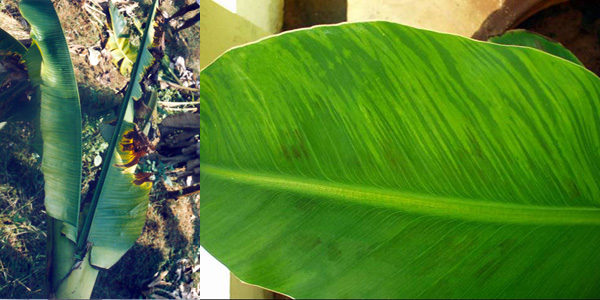
|
Importance of the
problem |
Infectious
chlorosis is one of the most common diseases of banana. The disease
causes yellowish green patches and thickening of veins. Leaf sheaths
also pull away from the pseudostem easily. Since, the disease is
caused by virus, chemical control is of no use. Therefore, special
care should be taken to prevent disease infestation.
|
|
Common signs and
symptoms |
•
Chlorotic or yellowish green bands and patches or mottling seen over
the entire area of young leaves
• Parallel chlorotic streaks develop on the younger leaves giving a
striped appearance
• Subsequently produced leaves become small and distorted
• Margins become irregularly wavy, often with mosaic mottling and
blotches of necrotic tissues
• In severe cases, rotted areas are found through out the leaf
sheath and pseudostem
• Diseased plants do not reach maturity. Occasionally, they produce
a bunch of fruit which never matures and is unfit for consumption
• Affected plants become stunted
• Youngest leaf shows chlorosis and rots resulting in heart rot
• Disease is noticed in many cultivable varieties like Nendran,
Palyankodan, Karpooravally, Rasthali etc.
|
|
Problems with similar
symptoms |
Infectious chlorosis produces symptoms
that are common to any of the viral diseases. However, the disease
causes yellowish green patches and thickening of veins. Leaf sheaths
also pull away from the pseudostem easily.
|
|
Causal organism and
their spread |
Infectious chlorosis is caused by a
virus called cucumber mosaic virus. The disease is transmitted
locally in a non-persistent manner by the melon aphid (Pentalonia
gossypii). Distribution over long distances occurs by the movement
of infected vegetative planting material such as suckers, corms, and
tissue-cultured plantlets. Infectious chlorosis disease is not
soil-borne and is unlikely to be spread on cutting tools. Cucumber
and Cucumis sativus var Khira serves as reservoir of the virus.
|
|
Mechanism of damage |
The disease causes yellowish green
patches and thickening of veins. Leaf sheaths also pull away from
the pseudostem easily. This in turn results in considerable
reduction in photosynthetic area and affects growth.
|
|
Ideal management
strategy |
• Eradicate
and destroy all infected plants including suckers along with roots
• Affected stools can be destroyed by spraying kerosene or by injecting
herbicides like 2,4-D
• Do not take suckers from affected fields
• Use disease free suckers for planting. Use tissue culture plants and
certified, disease free suckers
• Observe strict quarantine regulations in disease free areas
• Avoid growing leguminous and cucurbitaceous vegetables as intercrop
• Before planting, spread lemon grass in the pits |
|
References |
1. Jones, D.
R., (1998) Diseases of Banana, Abaca and Enset, CABI Publishing, United
Kingdom
2. NRCB (1998) Banana Cultivation: Technical Know How and Do How,
National Research Centre on Banana, Tiruchirapally
3. Rao, V N M (1998) Banana, Indian Council of Agricultural Research,
New Delhi.
4. KAU (2002) Package of Practices Recommendations: Crops, Kerala
Agricultural University, Vellanikkara. |
Leaf Eating Caterpillar Attack in Banana
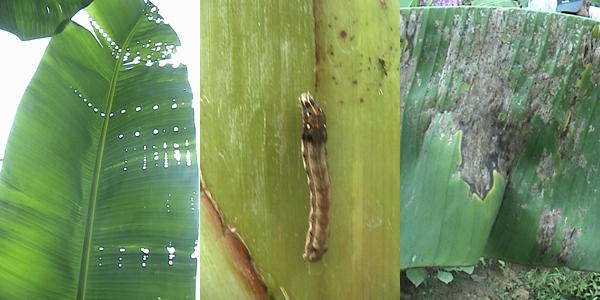
|
Importance of the
problem |
Leaf eating
caterpillars cause damage to leaf by defoliation. The caterpillars
attack banana in groups during the early growth stages causing
drying up of leaf in patches. The affected
leaves shows irregular holes on them. The larvae remains hidden in
the leaf axils during day time and feeds at night. When the
population of the caterpillar is high, we need to adopt management
tactics.
|
|
Common signs and
symptoms |
-
These
are smooth cater pillars. In the young stages, they can be seen
in masses on the leaves scraping the green matter resulting in
scarring on the leaves
-
Grown
up caterpillars hide in the leaf axils or at the plant base in
soil or undersurface of dried leaves and bore the emerging leaf
entering from the leaf axils. This results in occurrence of bore
holes in a pattern as the leaf unfurls
|
|
Problems with similar
symptoms |
Other caterpillars also cause damage
of similar nature. However, at management level, the strategy is
more or less similar.
|
|
Causal organism and
their spread |
Spodoptera litura
This is the caterpillar of a stout
built moth measuring 3-8 cm in wing span and 1-8 cm in body length.
The forewings are greyish brown with fine white zig-zag lines on
them and the hind wings are white. Eggs are laid in batches covered
with hairs on the leaves. A female lays upto 2000 eggs. Eggs hatch
in a week. The larvae feeds on the tender leaves and become full
grown in 2-3 weeks. The full fed larva is 3.7 cm long. The body is
pale greenish brown with dark markings and a black ring encircling
the body at both ends. It pupates in soil for one week.
|
|
Mechanism of damage |
The caterpillar feeds on the young
leaves causing shot holes and eaten up areas. This considerably
reduce the photosynthetic area and thereby growth and development.
|
|
Ideal management
strategy |
• If severe,
apply any contact insecticide at the leaf axils like Quinalphos 25EC 1.5
ml/L or Carbaryl 50 WP 2g/L
• In order to attract and kill the hiding larvae of Spodoptera, prepare
food attractant by making small balls using 100g rice bran, 10g jaggery
and 2g sevin 50WP. Disperse these balls in the field at the plant base |
|
References |
1. Jones, D.
R., (1998) Diseases of Banana, Abaca and Enset, CABI Publishing, United
Kingdom
2. NRCB (1998) Banana Cultivation: Technical Know How and Do How,
National Research Centre on Banana, Tiruchirapally
3. Rao, V N M (1998) Banana, Indian Council of Agricultural Research,
New Delhi.
4. KAU (2002) Package of Practices Recommendations: Crops, Kerala
Agricultural University, Vellanikkara. |
Magnesium Deficiency Disorder in Banana
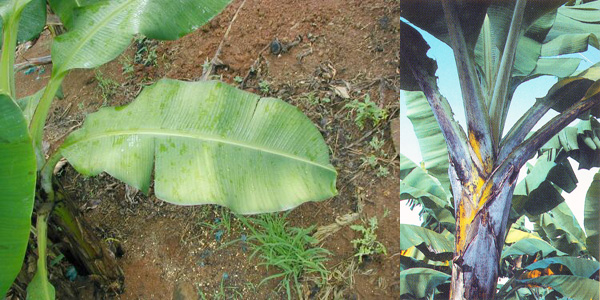
|
Importance of the
problem |
Magnesium is an
element closely associated with photosynthesis and protein
synthesis. To establish a crop yielding 50 tones per hector per
year, the plant need 125 kg of magnesium per hector per year. If
sufficient quantity of organic manure and mineral nutrients are not
added, deficiency of magnesium will be noticed.
|
|
Common signs and
symptoms |
• Typical
deficiency symptom is yellowing of outside section of the lamina in
older leaves, which is due to its mobility in the plant
• As the deficient leaf matures, chlorosis becomes more intense, and
dark spots appear, that later become necrotic
• Affected leaves turns to intense golden yellow in colour
• Leaf arrangement is affected, leading to a rosette appearance
• Another characteristic symptom is a bluish-purple colouration on
the petioles called blue sickness
• When deficiency is severe, the basal section of the petiole
separates and breaks from the pseudostem, causing early leaf
senescence
|
|
Problems with similar
symptoms |
Deficiency symptoms caused by nutrient
elements are characterized by the part in which symptoms are
exhibited. In case of deficiency of iron, sulphur, boron, zinc and
calcium, the symptoms are seen first on the younger leaves. But for
phosperous, magnesium, manganese and potassium, the symptoms are
first exhibited in the older leaves.
Calcium and sulphur deficiency symptoms also show similarity with boron
deficiency symptoms. In calcium deficiency, there is marginal chlorosis and in sulphur deficiency pale green to yellow
discoloration. These can be distinguished from boron deficiency
where there are perpendicular streaks across the veins.
|
|
Causal organism and
their spread |
Mg deficiency can be caused by either
of the following:
• Low available soil Mg.
• Decreased Mg uptake due to a wide ratio of exchangeable K:Mg
(i.e., >1:1).
|
|
Mechanism of damage |
Magnesium activates several enzymes.
It is a constituent of chlorophyll, and thus is involved in CO2
assimilation and protein synthesis because it activates several
enzymes and is a constituent of chlorophyll. Mg also regulates
cellular pH and the cation-anion balance. It is very mobile and is
retranslocated easily from old leaves to young leaves. Deficiency
symptoms therefore tend to occur initially in older leaves.
|
|
Ideal management
strategy |
• Apply
organic manure at the recommended rate (10 kg per plant)
• Apply MgSO4 @ 20 g/plant. Alternatively, spraying magnesium sulphate @
2 g/L of water effectively corrects the deficiency |
|
References |
1. Jones, D.
R., (1998) Diseases of Banana, Abaca and Enset, CABI Publishing, United
Kingdom
2. NRCB (1998) Banana Cultivation: Technical Know How and Do How,
National Research Centre on Banana, Tiruchirapally
3. Rao, V N M (1998) Banana, Indian Council of Agricultural Research,
New Delhi.
4. KAU (2002) Package of Practices Recommendations: Crops, Kerala
Agricultural University, Vellanikkara. |
Main Stalk Rot Disease of Banana

|
Importance of the
problem |
Main stalk rot is an important storage
disease of banana. The disease occurs when banana is exported in
bunches. Decay of the peduncle and dropping of fruits are the major
symptoms. Therefore, care should be taken to avoid the development
of the disease.
|
|
Common signs and
symptoms |
-
Decay
of the peduncle region of the bunch
-
Rotting of the fruit starting from the proximal end.
-
Production of characteristic sweetish order.
Drooping of fingers from the lower bunch.
|
|
Problems with similar
symptoms |
The symptoms are very much
characteristic of the disease.
|
|
Causal organism and
their spread |
The disease is caused by a fungus
Fusarium moniliforme var subglutinans. The disease occurs when
banana is exported in bunches.
|
|
Mechanism of damage |
The fungus on infection causes
distraction to the plant tissue. This in turn affects the market
value of the fruits.
|
|
Ideal management
strategy |
|
|
References |
1. Jones, D.
R., (1998) Diseases of Banana, Abaca and Enset, CABI Publishing, United
Kingdom
2. NRCB (1998) Banana Cultivation: Technical Know How and Do How,
National Research Centre on Banana, Tiruchirapally
3. Rao, V N M (1998) Banana, Indian Council of Agricultural Research,
New Delhi.
4. KAU (2002) Package of Practices Recommendations: Crops, Kerala
Agricultural University, Vellanikkara. |
Mealy Bug Damage in Banana
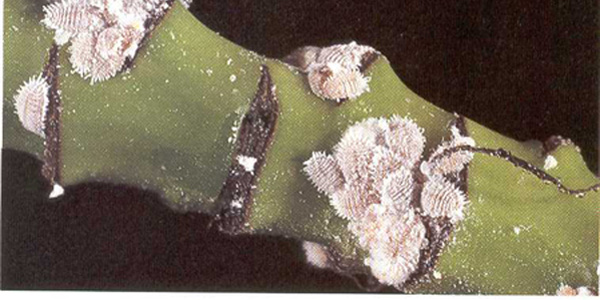
|
Importance of the
problem |
There are a number
of sucking pests that suck the sap from banana leaf. The common pest
includes mealy bug, scales, thrips etc. These pests suck the sap
from the banana leaf and cause yellowing and wilting. Therefore,
controlling these pests is very important in banana cultivation.
|
|
Common signs and
symptoms |
•
Yellowish discolouration of the affected area as a result of sucking
of sap.
• The pest colonize in certain areas only resulting in non uniform
pattern of damage
|
|
Problems with similar
symptoms |
Yellowing, wilting and stunted growth
results out from a number of problems. However, presence of small
insect colonies confirms the basic cause of the problem.
|
|
Causal organism and
their spread |
The common pests include the mealy
bugs and thrips. The mealy bug can be easily distinguished as small
whitish colonies of insects. The increased ant activity confirms
their occurrence. Another, important pest is the thrips. The thrips
are characterized by the production of galls.
|
|
Mechanism of damage |
Both the adults and nymphs remove
plant sap using their sucking mouthparts.
|
|
Ideal management
strategy |
• Spray with Dimethoate 1.5ml/L
• Biological control can suppress the mealy bugs. Small encyrtid wasps
parasitize mealy bugs. Spiders, chloropid fly, drosophilid, and lady
beetles are predators of the mealy bugs. |
|
References |
1. Jones, D.
R., (1998) Diseases of Banana, Abaca and Enset, CABI Publishing, United
Kingdom
2. NRCB (1998) Banana Cultivation: Technical Know How and Do How,
National Research Centre on Banana, Tiruchirapally
3. Rao, V N M (1998) Banana, Indian Council of Agricultural Research,
New Delhi.
4. KAU (2002) Package of Practices Recommendations: Crops, Kerala
Agricultural University, Vellanikkara. |
Moko or Bacterial Wilt Disease of Banana
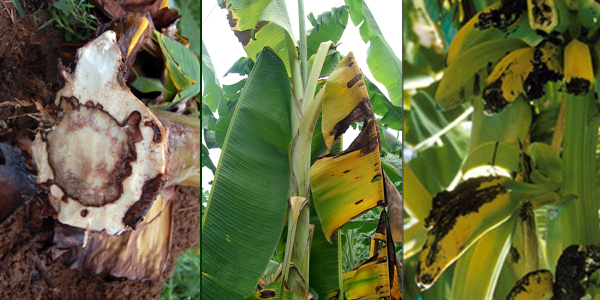
|
Importance of the
problem |
Moko wilt is an
important bacterial disease of banana. The disease is prevalent
throughout the country. And almost all varieties of banana are
susceptible to the disease. The primary symptom of the disease is
sudden wilting of the plant. The wilted plant later get dried up and
even collapse. And the infested bunches are rejected in export
market. Therefore, control of the disease is very much important in
banana cultivation.
|
|
Common signs and
symptoms |
•
Affected plants show rapid wilting and collapse of the younger
leaves
• Later, these symptoms progress towards the older leaves
• In Cavendish varieties, the lower leaves develop a yellowish tinge
which quickly spreads all over the leaves
• Leaves acquire a tingly whitish-yellow appearance, become dry,
flaccid and readily droop around the pseudostem
• Petiole breaks at its junction with lamina or pseudostem
• If the diseased suckers are planted, terminal leaf becomes
necrotic and the plant dies
• Infected young sword suckers show wilting and blackening
• Vascular discolouration ranging from pale yellow to dark brown or
bluish black in the form of a ring is seen at the central part of
the pseudostem, when it is cut transversely
• Slimy drops of bacterial ooze which is greyish brown in colour
appears at the transverse cut end of the pseudostem
• When fruit bunch is produced, the fingers appear distorted and
turn yellow resulting in premature ripening of fruits
• The pulp turns into a very characteristic dark brown colour
• Blackened necrotic male buds with infection moving up the fruit
stalk is another characteristic symptom
|
|
Problems with similar
symptoms |
Panama wilt is often confused with
moko disease. However, external symptom of panama wilt appears only
after four months. But in case of moko disease, it is seen right
from the beginning. The reddish tinge observed in case of Panama
wilt is usually absent
|
|
Causal organism and
their spread |
Moko disease is caused by bacteria
called Pseudomonas solanacearum (Syn. Ralstonia solanacearum). The
bacterium is non-spore forming, gram-negative, short and rod shaped.
The bacterium is readily transmitted from plant to plant by the
pruning or cutting instruments. Spread can also occur from root to
root. Insects like bees, wasps, and fruit flies also help in
transmitting the bacterium.
|
|
Mechanism of damage |
Systematic invasion of the vascular
system results in impairment of water movement followed by wilting.
The growth regulating substance (indole 3 acetic acid), a metabolite
of the pathogen also plays a role in pathogenesis. The premature
yellowing is believed to be due to ethylene production by the
pathogen. The bacteria lack tyrosinase and polyphenoloxidase and
browning of vascular elements may be host response to infection. The
major sources of infection are weed hosts, soils, infected roots and
insects. Disease symptoms may appear in about 6th to 12th week after
infection.
|
|
Ideal management
strategy |
• Eradicate
and destroy suckers. Subsequently, disinfect the area with 0.1%
bleaching powder(1g/L) solution
• Avoid furrow irrigation and follow basin irrigation
• Disinfect the irrigation water with 0.1% bleaching powder solution
• Spread bleaching powder or 10 % fresh cow dung slurry (100g/L) in the
plant basin
• Drench soil with 1% Bordeaux mixture or 0.4% Copper oxychloride(4g/L)
• Use disease free planting material
• Remove Heliconia spp. and weeds from the field and nearby area
• Disinfect implements and tools used in the field
• Provide better drainage
• Leave the soil fallow for 6 months, especially in summer
• Adopt crop rotation with non-host crops for 12 months
• Before planting treat suckers with 0.4% copper oxychloride (4g/L) for
30 minutes
• Drench soil with antibiotics like Streptomycin / Streptocycline 500ppm
(5 g/10 liters) |
|
References |
1. Jones, D.
R., (1998) Diseases of Banana, Abaca and Enset, CABI Publishing, United
Kingdom
2. NRCB (1998) Banana Cultivation: Technical Know How and Do How,
National Research Centre on Banana, Tiruchirapally
3. Rao, V N M (1998) Banana, Indian Council of Agricultural Research,
New Delhi.
4. KAU (2002) Package of Practices Recommendations: Crops, Kerala
Agricultural University, Vellanikkara. |
Damage Caused because of Monkey Attack

|
Importance of the
problem |
Monkey can cause
great damage to banana plantation by way of eating the fruit.
Normally, monkeys come in large numbers and eat the ripe fruit.
Therefore, having an eye on their movement is very much important in
areas where their population is high.
|
|
Common signs and
symptoms |
• Fruits
will be eaten after removing their peel.
• Partially eaten fruits can also be seen.
|
|
Problems with similar
symptoms |
Presence of monkeys in the area
confirms the attack
|
|
Causal organism and
their spread |
Monkeys cause the damage.
|
|
Mechanism of damage |
Monkeys come in large numbers and eat
the ripe fruit.
|
|
Ideal management
strategy |
Control
attack from monkeys by way of covering the fruit. |
|
References |
1. Jones, D.
R., (1998) Diseases of Banana, Abaca and Enset, CABI Publishing, United
Kingdom
2. NRCB (1998) Banana Cultivation: Technical Know How and Do How,
National Research Centre on Banana, Tiruchirapally
3. Rao, V N M (1998) Banana, Indian Council of Agricultural Research,
New Delhi.
4. KAU (2002) Package of Practices Recommendations: Crops, Kerala
Agricultural University, Vellanikkara. |
Nettle Grub Attack in Banana
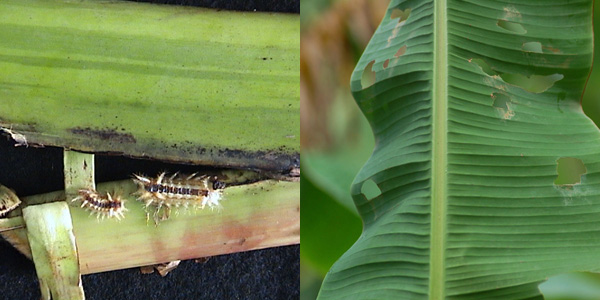
|
Importance of the
problem |
Nettle grub is a
defoliating caterpillar in banana. The caterpillars attack banana
during the
rainy season. The affected leaves shows irregular holes on them. The
larvae remains hidden in the leaf axils during day time and feeds at
night. When the population of the caterpillar is high, we need to
adopt management tactics.
|
|
Common signs and
symptoms |
• The
caterpillars are creamy white and have stout bristle like hairs
which produce strong allergic reactions on touch • They feed
on emerging leaves by staying at the leaf axils resulting in
shapeless holes on the leaves
|
|
Problems with similar
symptoms |
Other caterpillars also cause damage
of similar nature. However, at management level, the strategy is
more or less similar.
|
|
Causal organism and
their spread |
|
|
Mechanism of damage |
The caterpillar feeds on the young
leaves causing shot holes and eaten up areas. This considerably
reduce the photosynthetic area and thereby growth and development.
|
|
Ideal management
strategy |
-
Collection and distruction of the larvae hiding in the leaf axils.
-
If
severe, apply any contact insecticide at the leaf axils like
Quinalphos 25EC 1.5 ml/L or Carbaryl 50 WP 2g/L
|
|
References |
1. Jones, D.
R., (1998) Diseases of Banana, Abaca and Enset, CABI Publishing, United
Kingdom
2. NRCB (1998) Banana Cultivation: Technical Know How and Do How,
National Research Centre on Banana, Tiruchirapally
3. Rao, V N M (1998) Banana, Indian Council of Agricultural Research,
New Delhi.
4. KAU (2002) Package of Practices Recommendations: Crops, Kerala
Agricultural University, Vellanikkara. |
Nitrogen Deficiency Disorder in Banana
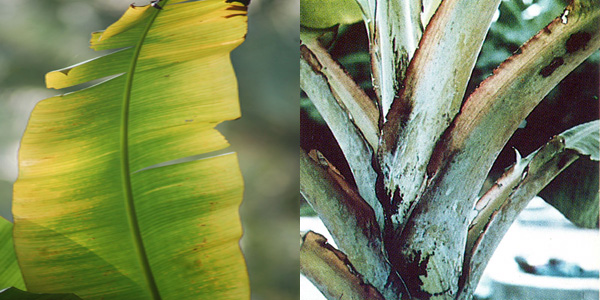
|
Importance of the
problem |
Nitrogen is an
important nutrient needed for proper growth and development. To establish a crop yielding 50 tones per hectar per year,
the plant need approximately 388 Kg of nitrogen per hectar per year.
Further, the amount of nitrogen absorbed has a direct correlation
with the yield of the plant. Therefore, application of the correct
amount of nutrient in the right method is very much essential for
banana cultivation.
|
|
Common signs and
symptoms |
• The
most evident symptom is yellowing of leaves resulting from a
reduction in chlorophyll content
• Yellowing commences in the older, lower leaves and subsequently
affect younger leaves as the deficiency worsens.
• Petioles of the most affected leaves become short and show a
pinkish discoloration
• Leaves emerge and develop on the top of each other resulting in a
rosette appearance
• Plant height and leaf length is considerably reduced
• Growth and development is delayed and rate of leaf production
|
|
Problems with similar
symptoms |
The visual symptoms of N deficiency
can be confused with those of S deficiency, but S deficiency is less
common and tends to first affect younger leaves. Mild N deficiency
can be confused with Fe deficiency, but the latter affects the
emerging leaf first. Similarly, Nitrogen deficiency will result in
yellowing of the leaves. Similar symptoms are also produced in cases
of severe weed competition, drought, water logging etc.
|
|
Causal organism and
their spread |
Nitrogen deficiency can be resulted
due to many factors. As a first case there is no nitrogen addition
and the field is under cultivation for a longer time. A second case
is low nitrogen fertilizer use efficiency. This happen when loss of
nitrogen happens through volatilization, de-nitrification, incorrect
timing and placement. Loss in the form of leaching and seepage can
happen when there is heavy rainfall. Another case is low soil
microbial activity and poor biological nitrogen fixation.
|
|
Mechanism of damage |
N is an essential constituent of amino
acids, nucleic acids, nucleotides, and chlorophyll. The
photosynthetic rate and biomass production have a direct correlation
with nitrogen uptake. Further, it also affects most of the yield
parameters. So the deficiency of nitrogen affects the normal growth
and development of the plant. As a consequent the biomass production
and total yield of the plant will be affected.
|
|
Ideal management
strategy |
• Apply
compost, cattle manure or green leaves at the rate of 10 kg per plant at
the time of planting.
• Apply fertilizers at the recommended dose as per the schedule
• Apply the fertilizer in two equal split doses; the first, two months
after planting and the second, four months after planting. For ratoon
crop, apply the entire fertilizers in a single dose immediately after
the harvest of the preceding crop. Irrigate immediately after manuring.
• For Nendran, apply the fertilizers in six split doses as detailed
• After planting banana, sow sunhemp / daincha / cowpea adopting a seed
rate of 50 kg/ha. Incorporate the crop into the soil 40 days after
sowing. Repeat sowing of green manure crop and incorporate into soil 40
days after sowing |
|
References |
1. Jones, D.
R., (1998) Diseases of Banana, Abaca and Enset, CABI Publishing, United
Kingdom
2. NRCB (1998) Banana Cultivation: Technical Know How and Do How,
National Research Centre on Banana, Tiruchirapally
3. Rao, V N M (1998) Banana, Indian Council of Agricultural Research,
New Delhi.
4. KAU (2002) Package of Practices Recommendations: Crops, Kerala
Agricultural University, Vellanikkara. |
Panama Wilt or Bacterial wilt Disease
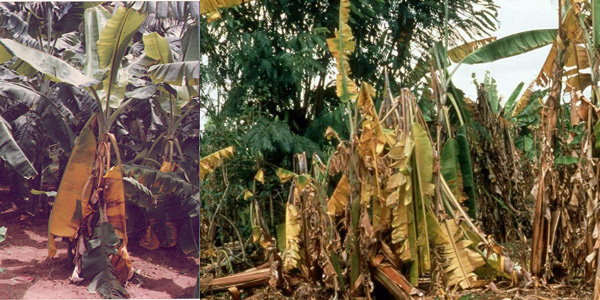
|
Importance of the
problem |
Panama wilt is a
major disease of banana. The disease is prevalent throughout the
country. And almost all varieties of banana are susceptible to the
disease. The primary symptom of the disease is sudden wilting of
leaves and hanging of them around pseudostem. The wilted plant later
get dried up and even collapse. And the infested bunches are
rejected in export market. Therefore, control of the disease is very
much important in banana cultivation.
|
|
Common signs and
symptoms |
• The
leaves wilt, the petiole buckles and the leaf hangs between the
pseudostem and the middle of lamina, while the leaf is still green
• The spindle leaf often stands green and erect while all other
leaves wither, become yellowish-orange, collapse around the
pseudostem and die
• Characteristic yellowing of older leaves accompanied by vascular
discoloration in the outer leaf sheath
• The yellowing develops as a band along the margin and spreads
towards the midrib
• Outer leaf sheaths of pseudostem above the soil level split
longitudinally and pseudostem becomes hard
• Finally, the top leaf withers and dies
• The pseudostem soon gets surrounded by a number of daughter
suckers, which are often not infected
• Dwarfing and stunting of young and old plants
• Roots show reddish discolouration and rot
• When an affected rhizome is cut transversely, reddish vascular
strands appear as yellow, red or brown dots and streaks
• The diseased vascular strands become numerous and get deeply
stained to form a reddish brown ring
• Typical vascular bundle discolouration is noticed in pseudostem
and leaf sheath
• Yellow colour develops in the innermost or youngest leaf sheath
and dark red to brown colour in the older or outer leaf sheaths
• The infected pseudostem and rhizome emits a characteristic foul
odour and the plant dies
|
|
Problems with similar
symptoms |
Panama wilt is often confused with
moko disease. However, external symptom of panama wilt appears only
after four months. But in case of moko disease, it is seen right
from the beginning. Further, in moko disease internal portion of
fruits are discolored, but not in panama wilt.
|
|
Causal organism and
their spread |
The soil born fungus Fusarium
oxysporum is the cause of fusarium wilt. The fungus survives in the
form of chlamidospores. The spread of the disease mainly happens
through infested planting materials. The dissemination also happens
through water and farm implements.
|
|
Mechanism of damage |
Root tips are the natural, initial
sites of infestation. Chlamidospores germinate in response to
exudates that originate from root tip. Later, they move to
pseudostem and colonize the xylem tissues. These ultimately result
in blockage of translocation of water and nutrients to different
plant parts. And as consequence symptoms of the disease occurs.
|
|
Ideal management
strategy |
• Grow
resistant varieties like Giant Cavendish, Palayankodan, Robusta, Nendran
etc. and avoid growing highly susceptible varieties like Gros Michel
• Remove and destroy infected plants along with roots at first sight of
disease incidence followed by liming of infected pits @ 1 kg/pit
• Use disease free healthy planting material
• Avoid any sort of root injury through intercultural operations or by
nematode infestation
• Flood fallow severely infected areas for 6-12 months
• Dip suckers in 0.2-0.3% bavistin (2-3g/L) solution before planting
• Drench the soil around the affected clumps with 0.2-0.3% Bavistin
(2-3g/L) or 0.1-0.2% Calixin/Contaf/Tilt (1-2ml/L) to prevent the spread
of the disease
• Drench soil with vapam 2850g in 100 litres of water or 1% Bordeaux
mixture
• Place of 2-3 Bavistin capsules in rhizome and at the base of
pseudostem |
|
References |
1. Jones, D.
R., (1998) Diseases of Banana, Abaca and Enset, CABI Publishing, United
Kingdom
2. NRCB (1998) Banana Cultivation: Technical Know How and Do How,
National Research Centre on Banana, Tiruchirapally
3. Rao, V N M (1998) Banana, Indian Council of Agricultural Research,
New Delhi.
4. KAU (2002) Package of Practices Recommendations: Crops, Kerala
Agricultural University, Vellanikkara. |
Problem Because of Pesticide Toxicity
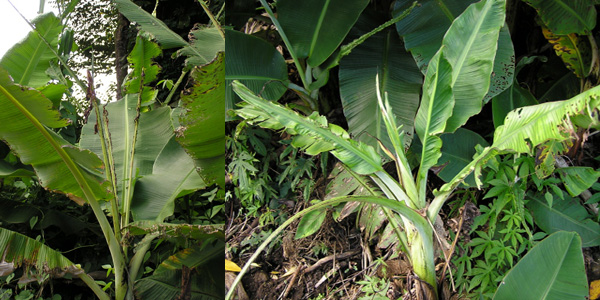
|
Importance of the
problem |
Pesticides are
chemicals used in the field to control weeds, insects and diseases.
But, in some situations the use of pesticides moves over and above
the recommended dosage. And a number of plant level symptoms
results. Therefore, special care should be taken not to confuse
pesticide toxicity with normal problems.
|
|
Common signs and
symptoms |
• Excess
fertilizer application will result in marginal chlorosis of lower
leaves followed by necrosis. A whitish discolouation or brown band
appears, similar to sun burn apperras on the 2-5 leaves.
• Tridemorh applications for control of disease when goes overdose
will result in yellowing of the leaf.
• Paraquat toxicity causes local chlorosis and necrosis on direct
contact with leaves or live leaf sheaths.
• Glyphosate toxicity causes reduced growth rate, typical chlorosis
and lamina deformations on younger leaves.
• Oxyfluorfen toxicity causes leaf necrosis on direct contact,
marginal leaf necrosis when affected by gaseous form.
• Diuron toxicity causes yellowing along midrib of older leaves,
spreading towards the margins; reduced growth rate.
|
|
Problems with similar
symptoms |
The toxicity of chemical causes
yellowing and chlorosis symptoms which are common to various
nutrition deficiency disorders.
|
|
Causal organism and
their spread |
The problems typically happen if
products are not used according to their recommendations - e.g., at
the incorrect dosage, the wrong stage of crop growth, or sometimes if the
product is carried into contact with the plant parts (e.g., water
infiltration moves the product into the soil).
|
|
Mechanism of damage |
The effect varies, but damage may
occur due to contact or due to translocation within the plant.
Damage occurs at the time of or shortly after product application.
|
|
Ideal management
strategy |
• Use
pesticide as and when required at the recommended dose only. |
|
References |
1. Jones, D.
R., (1998) Diseases of Banana, Abaca and Enset, CABI Publishing, United
Kingdom
2. NRCB (1998) Banana Cultivation: Technical Know How and Do How,
National Research Centre on Banana, Tiruchirapally
3. Rao, V N M (1998) Banana, Indian Council of Agricultural Research,
New Delhi.
4. KAU (2002) Package of Practices Recommendations: Crops, Kerala
Agricultural University, Vellanikkara. |
Phosphorous Deficiency Disorder in Banana

|
Importance of the
problem |
Phosphorous play
the major functions in energy storage and transfer and membrane
integrity. To establish a crop yielding 50 tones per hectar per
year, the plant need 52 kg of phosphorous per hector per year. If
sufficient quantity of organic manure and mineral nutrients are not
added, deficiency of phosphorous will be noticed.
|
|
Common signs and
symptoms |
• Leaves
exhibit slight marginal chlorosis followed by irregular necrosis
• Necrosis proceeds very rapidly and entire leaf dries prematurely
• Elongation ceases completely at a height of about 2 feet
• Leaf production is reduced
• Rosetting of leaves happens
|
|
Problems with similar
symptoms |
Phosphorous
deficiency will produce dark green
leaves that may be confused with excessive N application. P
deficiency is often associated with other nutrient disorders such as
Fe toxicity at low pH, Zn deficiency, Fe deficiency, and salinity in
alkaline soils
|
|
Causal organism and
their spread |
Phosphorous
deficiency is caused when
the recommended soil concentration of
Phosphorous
in soil goes below
the recommended range. And the possible reasons are:
Low indigenous soil P-supplying power.
• Insufficient application of mineral P fertilizer.
• Low efficiency of applied P fertilizer use due to high P-fixation
capacity or erosion losses
• P immobilization in Ca phosphates due to excessive liming.
• Excessive use of N fertilizer with insufficient P application.
|
|
Mechanism of damage |
Phosphorus is an essential constituent
of adenosine triphosphate (ATP), nucleotides, nucleic acids, and
phospholipids. Its major functions are in energy storage and
transfer and membrane integrity. It is mobile within the plant and
promotes root development, early flowering, and ripening (especially
where the temperature is low). It is particularly important in early
growth stages. P is remobilized within the plant during later growth
stages if sufficient P has been absorbed during early growth.
|
|
Ideal management
strategy |
• Apply
compost, cattle manure or green leaves at the rate of 10 kg per plant at
the time of planting.
• Apply fertilizers at the recommended dose as per the recommended
schedule
• Apply the fertilizer in two equal split doses; the first, two months
after planting and the second, four months after planting. For ratoon
crop, apply the entire fertilizers in a single dose immediately after
the harvest of the preceding crop. Irrigate immediately after manuring.
• After planting banana, sow sunhemp / daincha / cowpea adopting a seed
rate of 50 kg/ha. Incorporate the crop into the soil 40 days after
sowing. Repeat sowing of green manure crop and incorporate into soil 40
days after sowing
• Use either Rajphos or Ultraphos as source of Phosphorous |
|
References |
1. Jones, D.
R., (1998) Diseases of Banana, Abaca and Enset, CABI Publishing, United
Kingdom
2. NRCB (1998) Banana Cultivation: Technical Know How and Do How,
National Research Centre on Banana, Tiruchirapally
3. Rao, V N M (1998) Banana, Indian Council of Agricultural Research,
New Delhi.
4. KAU (2002) Package of Practices Recommendations: Crops, Kerala
Agricultural University, Vellanikkara. |
Potassium Deficiency Disorder in Banana
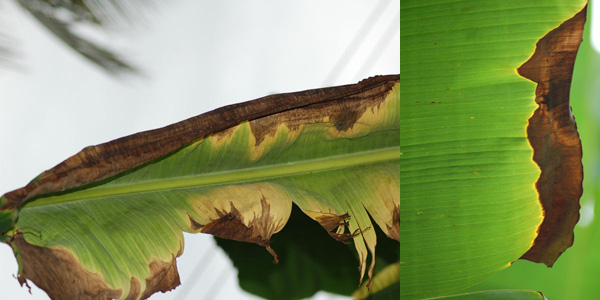
|
Importance of the
problem |
Potassium provides
strength to plant cell walls and increases leaf area and leaf
chlorophyll content. It improves the banana plant’s tolerance of
adverse climatic conditions, lodging, insect pests, and diseases.
Often, yield response to K fertilizer is only observed when the
supply of other nutrients, especially N and P, is sufficient.
|
|
Common signs and
symptoms |
•
Symptoms first appear on mature leaves and petioles
• The most characteristic symptom is the inward marginal yellowing
of older leaf followed by marginal necrosis
• Chlorosis progresses very rapidly and in a day or two the whole
leaf turns yellow with downward curling
• Subsequently the leaf dries up, petiole breaks and the leaf dies
prematurely
• In deficient plants, banana bunches are short, slim and deformed
as a consequence of poor fruit filling caused by reduced
photosynthesis and sugar transportation
|
|
Problems with similar
symptoms |
Leaf symptoms of K deficiency,
particularly the yellowish brown leaf margins, are similar to those
of virus diseases.
|
|
Causal organism and
their spread |
Deficiency of potassium at all stages
of growth causes the problem. Potassium deficiency results out of:
• Low soil K-supplying capacity.
• Insufficient application of mineral K fertilizer.
• Small inputs of K by irrigation (irrigation water low in K).
• Low recovery efficiency of applied K fertilizer because of high
K-fixation capacity or leaching losses.
• Presence of excessive amounts of reduced substances in poorly
drained soils (e.g., H2S, organic acids, Fe2+), resulting in
retarded root growth and reduced K uptake.
|
|
Mechanism of damage |
Potassium has essential functions in
osmoregulation, enzyme activation; regulation of cellular pH, the
cation-anion balance, regulation of transpiration by stomata, and
the transport of assimilates (the products of photosynthesis). K
provides strength to plant cell walls and is involved in the
lignification of sclerenchyma—tissues with thickened cell walls. On
the whole-plant level, K increases leaf area and leaf chlorophyll
content, delays leaf senescence, and therefore contributes to
greater canopy photosynthesis and crop growth.
K deficiency results in an accumulation of labile
low-molecular-weight sugars, amino acids, and amines that are
suitable food sources for leaf disease pathogens. Deficiency
symptoms tend to occur in older leaves first, because K is very
mobile within the plant and is re-translocated to young leaves from
old senescing leaves. Often, yield response to K fertilizer is only
observed when the supply of other nutrients, especially N and P, is
sufficient.
|
|
Ideal management
strategy |
• Apply
compost, cattle manure or green leaves at the rate of 10 kg per plant at
the time of planting.
• Apply fertilizers at the recommended dose as per the schedule
• Apply the fertilizer in two equal split doses; the first, two months
after planting and the second, four months after planting. For ratoon
crop, apply the entire fertilizers in a single dose immediately after
the harvest of the preceding crop. Irrigate immediately after manuring.
• For Nendran, apply the fertilizers in six split doses as detailed
• After planting banana, sow sunhemp / daincha / cowpea adopting a seed
rate of 50 kg/ha. Incorporate the crop into the soil 40 days after
sowing. Repeat sowing of green manure crop and incorporate into soil 40
days after sowing |
|
References |
1. Jones, D.
R., (1998) Diseases of Banana, Abaca and Enset, CABI Publishing, United
Kingdom
2. NRCB (1998) Banana Cultivation: Technical Know How and Do How,
National Research Centre on Banana, Tiruchirapally
3. Rao, V N M (1998) Banana, Indian Council of Agricultural Research,
New Delhi.
4. KAU (2002) Package of Practices Recommendations: Crops, Kerala
Agricultural University, Vellanikkara. |
Pseudostem Weevil Attack in Banana
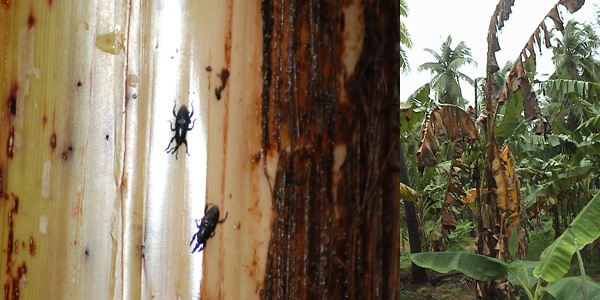
|
Importance of the
problem |
Pseudostem borer
is the most common and most serious pest of banana. Plant nearing
flowering are attacked by the weevil. The grub of the weevil tunnels
the pseudostem and cause greater damage to it. The visible symptoms
of the pest are yellowing of the lower leaves, oozing of colourless
jelly like viscous liquid from bore holes and seen on
pseudostem. Breaking of pseudostem can also happen in serious cases.
Hence, control of this pest is very much important in banana
cultivation.
|
|
Common signs and
symptoms |
• Adult
female weevil punctures and inserts eggs into the pseudostem. Grubs
emerging out feed extensively on the pseudostem and thereby causes
extensive tunnels inside.
• Colourless jelly like plant sap oozes out from minute boreholes on
the pseudostem or leaf bases. This is the first symptom.
• The ooze later turns deep violet in colour. Chewed up material
will also be pushed out through the holes
• Leaves turn yellow, dry up and finally, the plant collapses.
|
|
Problems with similar
symptoms |
Pseudostem weevil causes yellowing and
withering of lower leaves. Similar symptoms are also caused by rhizome rot,
panama wilt and drought. However, the black internal discolouation
and presence of grubs of the beetle inside the pseudostem confirms
the problem.
|
|
Causal organism and
their spread |
Banana pseudostem weevil Odoiporus
longicollis causes the damage. The weevil is reddish brown to black
and measures 23-28 mm in length. Eggs are laid in air chambers of
leaf sheath through slits cut on them. The apodous grub bores within
the pseudostem making extensive tunnels. It pupates within a fibrous
cocoon inside the tunnel. Life cycle is completed in 42 days. Adult
lives for 90-120 days.
|
|
Mechanism of damage |
The apodous grub bores within the
pseudostem making extensive tunnels. This in turn affects the
translocation of nutrients and plant shows yellowing symptoms.
Further, the severely infested pseudostem may break and or topple.
|
|
Ideal management
strategy |
• Field
sanitation is the most important factor in the prophylactic and curative
control of this pest. Regularly remove dried hanging leaves of the plant
and observe for early symptoms of the infestation
• Remove badly affected plants along with the rhizome in full and destroy
them. Burn the life stages of the insect using kerosene or by burying
the infested material in deep pits in soil
• Remove the parts of rhizome and pseudostem of harvested plants from
the field and destroy them as described above
• Trapping: Adults are attracted to freshly cut pseudostems. Use
split-log traps as described in the case of rhizome weevil
• Remove the dry outer sheaths of the pseudostem of all infested and
uninfested plants in the endemic areas and spray any of the recommended
insecticides. Drench the lower most 3 or 4 leaf axils and the entire pseudostem by inserting the nozzle through the bore
holes made by the larvae, if any, and also within the outer sheathes by
slightly raising the same at different spots.
Apply quinalphos 25EC 1.5
ml/L or chlorpyrifos 20EC 2.5ml/L or carbaryl 50WP 4 g/L. Repeat the
treatment after 3 weeks, if infestation persists |
|
References |
1. Jones, D.
R., (1998) Diseases of Banana, Abaca and Enset, CABI Publishing, United
Kingdom
2. NRCB (1998) Banana Cultivation: Technical Know How and Do How,
National Research Centre on Banana, Tiruchirapally
3. Rao, V N M (1998) Banana, Indian Council of Agricultural Research,
New Delhi.
4. KAU (2002) Package of Practices Recommendations: Crops, Kerala
Agricultural University, Vellanikkara. |
Rhizome Rot or Tip Over Disease of Banana

|
Importance of the
problem |
Rhizome rot is a
disease caused by bacteria in banana. The disease is prevalent
through out Kerala. The affected plants show discoloration and soft
rotting of rhizomes and suckers. In severe cases toppling of the
whole plant can happen. Therefore, appropriate management strategy
should be adopted to control the disease.
|
|
Common signs and
symptoms |
•
Affected plants show discolouration and soft rotting of rhizomes and
suckers
• They have scanty roots with dark brown lesions and necrotic tips.
• The entire roots get blackended and rotted
• Badly affected plants remain stunted with water-soaked,
discoloured leaf sheath bases and yellow leaf blades which give
scorched appearance
• Pockets of dark water soaked areas and cavities develop in the
rhizome
• Small sized fruits are produced which may fail to emerge from the
shoot tip
• Newly planted rhizomes rot and fail to sprout
• On close examination, a soft blackened ring is seen on the
pseudostem at the soil level
• The pseudostem tips over, breaking across the rotted portion,
particularly at the ground level
|
|
Problems with similar
symptoms |
Rhizomes rot result in overall
reduction in growth and development of the plant. Similar symptoms
occur in case of nematode attack and with nutrient deficiencies.
|
|
Causal organism and
their spread |
The disease is caused by bacteria
called Erwinia carotovora The disease is more common in wet weather,
particularly if the ground is poorly drained and field become
waterlogged.
|
|
Mechanism of damage |
The causal bacteria invade the rhizome
directly after planting via wounds or decaying leaf sheathes around
the central bud and cause the damage.
|
|
Ideal management
strategy |
•
Eradicate/destroy infected mats and suckers. Subsequently, disinfect the
area with 0.1% bleaching powder (1g/L) solution
• Avoid furrow irrigation and follow basin irrigation
• Disinfect the irrigation water with 0.1% bleaching powder (1g/L)
solution
• Spread bleaching powder or 10 % fresh cow dung slurry (100g/L) in the
banana basin
• Drench soil with 1% Bordeaux mixture or 0.4% copper oxychloride (4g/L)
• Use disease free planting material
• Remove Heliconia spp. and weeds from the field and nearby area
• Disinfect implements and tools used in the field
• Provide better drainage
• Leave soil fallow for 6 months, especially in summer
• Adopt crop rotation involving non-host crops for 12 months
• Before planting, treat suckers with 0.4% copper oxychloride (4g/L) 30
minutes
• Drench soil with antibiotics like Streptomycin / Streptocycline 500ppm
(500mg/L) |
|
References |
1. Jones, D.
R., (1998) Diseases of Banana, Abaca and Enset, CABI Publishing, United
Kingdom
2. NRCB (1998) Banana Cultivation: Technical Know How and Do How,
National Research Centre on Banana, Tiruchirapally
3. Rao, V N M (1998) Banana, Indian Council of Agricultural Research,
New Delhi.
4. KAU (2002) Package of Practices Recommendations: Crops, Kerala
Agricultural University, Vellanikkara. |
Rhizome Weevil Attack in Banana
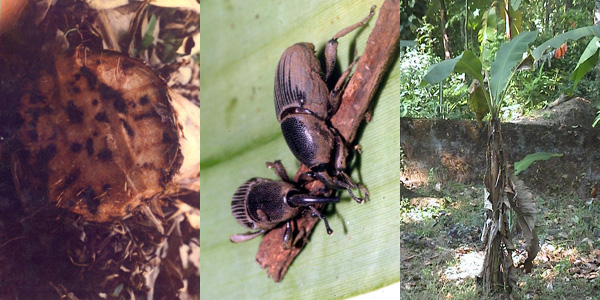
|
Importance of the
problem |
Rhizome weevil is
an important problem in banana cultivation. The grub of the weevil
bores the rhizome and causes damage. The primary symptom is the
death of the unopened leaves. This is followed by yellowing and
drying of the outer leaves. Therefore, control of this insect is
very much important in successful banana cultivation.
|
|
Common signs and
symptoms |
• Death
of the unopened leaves/ pipe leaf.
• Premature withering of outer leaves is also noticed.
• Injury caused by grubs (larvae), which tunnel through the
corms.
• Tunnels circular in cross section, become wider as the grub
grows and are filled with dark-coloured debris
• Extensive feeding damage by grubs results in root destruction,
slowed plant growth, scarcity of leaves. reduced fruit production,
and, sometimes, toppled plants
• The tunneling by the grubs make the corms susceptible to invasion
by secondary decay organisms.
• Production and growth of suckers reduced when parent plants are
heavily damaged
• Affected sucker plants can be recognized by their dull,
yellowish-green withered leaves. Relatively little damage is caused
by adults feeding on plant tissues.
|
|
Problems with similar
symptoms |
Rhizome weevil attack can be easily
distinguished by the presence grubs of the insect and feeding holes
on rhizome.
|
|
Causal organism and
their spread |
The female weevil deposits the eggs
singly in cavities in the corm or pseudostem at ground level. The
egg hatches in 5-8 days. The stout, creamy white, legless grubs have
reddish-brown heads and fleshy white bodies. The grubs are normally
found in the pseudostem upto 2 feet above the ground. It bores into
the rhizome making tunnels within and becomes full grown in about 25
days. Grubs pupate within chambers that are usually close to the
surface of the corms. The black, hard-shelled weevils are reported
to live for as long as 2 years. The life cycle (egg to adult) of the
weevil requires 30 to 40 days.
|
|
Mechanism of damage |
The damage is caused by the grub
boring into the rhizome. Extensive feeding damage by grubs results
in root destruction, slowed plant growth, scarcity of leaves.
reduced fruit production, and, sometimes, toppled plants
|
|
Ideal management
strategy |
-
Deep plough
the land to expose the inner soil layer to sun.
-
Trapping: Adults are attracted to freshly cut pseudostems and corms.
The split-log trap uses fresh banana pseudostems cut into 50 cm length.
The pseudostem logs are then split lengthwise through the center, and
the halves are placed with the split surfaces on the soil at a number of
locations in the field. Adult weevils can be collected and killed
-
Remove plant debris after harvesting from the field or chop into
several pieces and allow to dry or use for vermi-composting
-
Adult
weevils can be collected using the pheramons; Cosmolure, or
Cosmolure +
-
Cut and remove the outer layer of the rhizome and sundry for 3-4 days
after smearing it with slurry of cow dung and ash
-
Pesticide application suggested for managing banana bunchy top vector
will be helpful in controlling this pest also
-
Sucker
treatment with Carbaryl 0.2 % or Chlorpyriphos 0.05 % for 30 minutes
after clearing the suckers.
|
|
References |
1. Jones, D.
R., (1998) Diseases of Banana, Abaca and Enset, CABI Publishing, United
Kingdom
2. NRCB (1998) Banana Cultivation: Technical Know How and Do How,
National Research Centre on Banana, Tiruchirapally
3. Rao, V N M (1998) Banana, Indian Council of Agricultural Research,
New Delhi.
4. KAU (2002) Package of Practices Recommendations: Crops, Kerala
Agricultural University, Vellanikkara. |
Sigatoka Leaf Spot Disease of Banana
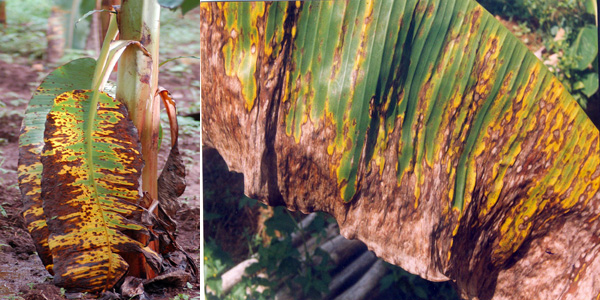
|
Importance of the
problem |
Sigatoka is one of
the most important fungal diseases of banana. The disease is
prevalent in almost all banana growing tracts. And almost all
varieties, particularly Nendran, are susceptible to the disease. The
fungus produces leaf spots which later joins and causes yellowing
and drying of leaves. Therefore, management of the disease is very
much important in banana cultivation.
|
|
Common signs and
symptoms |
-
The
first symptom of the disease is the appearance of a pale yellow/dark
brown/black streaks running parallel to veins, especially on lower
leaves
-
These streaks enlarge to form characteristic spots having dark
brownish to black, linear-oblong areas with ill-defined border,
often surrounded by yellow halo
-
Centre of the spots dries out, becoming light grey margined by
narrow dark brown or black border
-
Most often, many of yellow streaks result in premature yellowing
and drooping of leaves
-
The spots on lower leaves of young plants are dark brown and oval
to circular
-
Several spots coalesce resulting in extensive blighting and drying
of leaves
-
In severe case, the petioles collapse and the leaves hang down
from the pseudostem
-
Unfolded heart leaf and 2-3 youngest open leaves usually do not
show symptoms
|
|
Problems with similar
symptoms |
There are a number of leaf spots
diseases in banana. The leaf spot caused by Deightoniella torulosa
is characterized by an inverted ‘V’ shaped blightining from the
margin. In case of
freckle leaf spot, numerous minute black spots cover the leaf
lamina. The Sigatoka leaf spot is characterized by pale yellow/dark
brown/black streaks running parallel to veins, especially on lower
leaves.
|
|
Causal organism and
their spread |
Sigatoka leaf spot is caused by a
fungus called Mycosphaerella musicola. The fungus produces conidia
and ascospores which serve as inoculum. The inoculum spread
through water and air. And the growth of the fungus is accelerated
in hot and humid condition with frequent rains. The spread of the
fungus is rapid in closely planted fields.
|
|
Mechanism of damage |
The fungus on infection causes
distraction to the plant tissue. This in turn causes considerable
reduction in the photosynthetic area and thereby yield.
|
|
Ideal management
strategy |
• Remove and
destroy severely infected and completely dried leaves
• Spray 1% Bordeaux mixture or 0.4% Mancozeb (4g/L) along with stickers
at 2-3 weeks interval as prophylactic measure
• Power oil (mineral oil) 1% (10ml/L) emulsion is also effective in
controlling the disease
• Improve drainage, adopt weed control and proper spacing, remove excess
suckers
• In diseased crops, spray 0.1% Topsin M / Calixin / Contaf / Tilt
(1ml/L)/Bavistin (1g/L) at fortnightly intervals after adding stickers.
• Subsequently, drench soil with 0.1% Calixin / Contaf / Tilt (1ml/L)
• Oil based formulations of Copper oxychloride @ 0.2- 0.4% (2-4g/L) is
also very effective. |
|
References |
1. Jones, D.
R., (1998) Diseases of Banana, Abaca and Enset, CABI Publishing, United
Kingdom
2. NRCB (1998) Banana Cultivation: Technical Know How and Do How,
National Research Centre on Banana, Tiruchirapally
3. Rao, V N M (1998) Banana, Indian Council of Agricultural Research,
New Delhi.
4. KAU (2002) Package of Practices Recommendations: Crops, Kerala
Agricultural University, Vellanikkara. |
Squirrel Damage in Banana
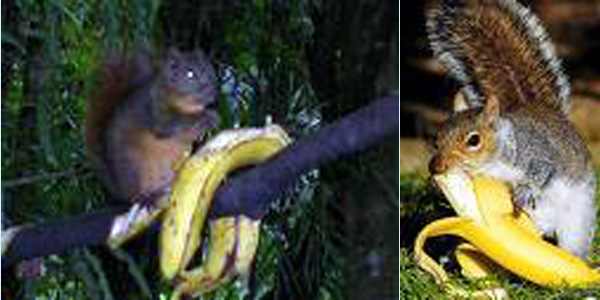
|
Importance of the
problem |
Squirrels are
common in our fields. At times they eat the fruit and cause damage
to the bunch. Therefore, having an eye on their movement will help
us to see what damage they cause.
|
|
Common signs and
symptoms |
• Fruits
eaten by squirrel will show characteristic holes on them.
• Milky substance covering the fruit
|
|
Problems with similar
symptoms |
Birds and squirrels cause damage of
similar type.
|
|
Causal organism and
their spread |
Birds and squirrel that comes in large
numbers when the fruit starts ripening cause the damage.
|
|
Mechanism of damage |
The birds eat the fruit through its
beak. The marking of the beak can be very well seen on the fruit.
Similarly the squirrel shows marking of the teeth.
|
|
Ideal management
strategy |
• Do not
allow the fruit to get ripen in the field.
• Cover the fruit so as to protect from the birds and squirrel
• Use bird scrappers and other ways to control birds and squirrel |
|
References |
1. Jones, D.
R., (1998) Diseases of Banana, Abaca and Enset, CABI Publishing, United
Kingdom
2. NRCB (1998) Banana Cultivation: Technical Know How and Do How,
National Research Centre on Banana, Tiruchirapally
3. Rao, V N M (1998) Banana, Indian Council of Agricultural Research,
New Delhi.
4. KAU (2002) Package of Practices Recommendations: Crops, Kerala
Agricultural University, Vellanikkara. |
Problem because of Water Stress

|
Importance of the
problem |
Drought is a
situation resulting from severe shortage of water. Banana plant
needs around 1200 liters of water at different stages of its growth
period. If that much water does not enter the soil through
irrigation or rainfall, symptoms of drought will be noticed. And, if
unchecked, drought can cause complete loss of the crop. Therefore,
adopting appropriate drought management strategy is very much
important for profitable cultivation of banana.
|
|
Common signs and
symptoms |
The
primary symptom of drought is wilting of the plant. The wilted leaf
slowly starts drying up and is noticed seen around the plant.
The growth of the plant will be reduced. The pseudostem also becomes
thin and weak due to the loss of water. And at a severe stage the
plant may break down in wind. The confirmation symptom for
drought is the presence of cracks in basins of the plant because of
acute water shortage.
|
|
Problems with similar
symptoms |
Symptoms of drought can be confused
with other problems like fusarium wilt, moko disease etc. however,
such problems are seen more in rainy season while drought in
summer.
|
|
Causal organism and
their spread |
Water stress results out of severe
shortage of water. This happens when there is no rainfall and also
no irrigation to supplement the water requirement of the plant.
|
|
Mechanism of damage |
The water uptake of the plant will be
affected. And as a consequence, most of the metabolic activity of
the plant will be stopped.
|
|
Ideal management
strategy |
1. The
scheduling of irrigation in accordance with the critical period of water
need is one method. In banana the critical months of irrigation starts
from the fourth month after planting and extends up to the eight month.
Therefore, adjusting the planting time to skip this period in the
droughty months should be adopted as far as possible.
2. A second method is conservation of applied water in the soil itself.
The addition of organic waste, cover crop and other water conservation
methods can be adopted for this purpose.
3. A third method is improving the efficiency of our irrigation system.
Most of our surface irrigation systems will have efficiency below 50 per
cent only. However, when we go for drip irrigation the efficiency can be
increased to around 80 percent. Further with limited quantity of water
more number of plants can be covered. Research also have showed an
increase of around 25 per cent in yield when farmers adopt drip
irrigation. |
|
References |
1. Jones, D.
R., (1998) Diseases of Banana, Abaca and Enset, CABI Publishing, United
Kingdom
2. NRCB (1998) Banana Cultivation: Technical Know How and Do How,
National Research Centre on Banana, Tiruchirapally
3. Rao, V N M (1998) Banana, Indian Council of Agricultural Research,
New Delhi.
4. KAU (2002) Package of Practices Recommendations: Crops, Kerala
Agricultural University, Vellanikkara. |
White Pipe Disorder in Banana
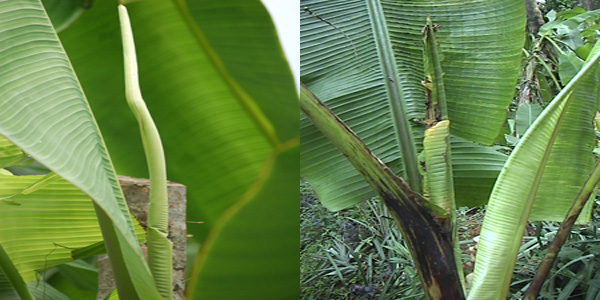
|
Importance of the
problem |
White pipe is a
disorder when banana plants outgrow their calcium or boron supply.
The unfurling of the heart leaf is delayed which results in white
pipe symptom. This normally occurs when there is a good summer
shower during severe summer season.
|
|
Common signs and
symptoms |
• When
banana plants outgrow their calcium or boron supply, unfurling of
the heart leaf is delayed which results in white pipe symptom
• Due to delayed unfurling, the heart leaf becomes necrotic and
subsequently rots
|
|
Problems with similar
symptoms |
The problem is characteristic of the
disorder and can be easily distinguished.
|
|
Causal organism and
their spread |
This occurs in the active growing
stage of the crop. When there is excess phosphorous in the soil, the
uptake of calcium or boron is affected resulting in this type of
symptom. In ratoon bananas which are neglected, white pipe is common
|
|
Mechanism of damage |
When banana plants outgrow their
calcium or boron supply, unfurling of the heart leaf is delayed
which results in white pipe symptom. Due to delayed unfurling the
heart leaf becomes necrotic and subsequently rots
|
|
Ideal management
strategy |
• Apply
organic manure at the recommended rate
• Apply lime as per necessity based on soil test result
• Apply borax @ 20-50 g/plant at the time of planting (in case of boron
deficiency) |
|
References |
1. Jones, D.
R., (1998) Diseases of Banana, Abaca and Enset, CABI Publishing, United
Kingdom
2. NRCB (1998) Banana Cultivation: Technical Know How and Do How,
National Research Centre on Banana, Tiruchirapally
3. Rao, V N M (1998) Banana, Indian Council of Agricultural Research,
New Delhi.
4. KAU (2002) Package of Practices Recommendations: Crops, Kerala
Agricultural University, Vellanikkara. |


































